Temporary Employment Agreement


Jump to Section
A temporary employment agreement is signed to oversee the conditions of an employment relationship that is supposed to last for a short period of time. This form of contract is made between a company with its potential individual employee or two different companies. It is also known as an interim employment agreement . By drafting an effective temporary employment agreement, a smooth and successful relationship between the two parties is ensured during the course of employment. This blog will discuss all the details concerning a temporary employment agreement. So, let's get started!
Essential Elements of a Temporary Employment Agreement
For an effective temporary employment agreement, the most important clauses or key elements are as follows:
- Job Title: It provides details regarding the nature of the work you ought to do by the temporary employment agreement. Specifically, it ensures that both the employee and the employer are clear about the duties and responsibilities of the employee. The agreement also includes a consensus ad idem , which means 'meeting of minds.'
- Salary, Bonuses & Benefits: This outlines the stipend that the employee would receive from the employer during the course of employment. This clause allows negotiation for both parties before entering the agreement. Also, it entails bonuses and certain benefits packages that the employee would receive as per their desire. This mainly includes the annual salary of hourly salary, bonuses, raises, health benefits, incentives, health benefits, retirement plans, signing bonuses, and other benefits.
- Length of Employment: Specifying the course of employment is very important before entering the agreement. It also includes the provisions for renewal of employment, if necessary, in the future. This section in the agreement sometimes is referred to as 'schedule.' If the employee can only work for certain days a week, such conditions must be specified in the contract.
- Holidays and Leaves: Specifying the leaves, time-offs, and holidays is an important element of an employment agreement. The agreement also includes a comprehensive time-off policy. It entails how the time off will be accrued on its use and what advantage the employee can take. The company policies specify these and also include details regarding the paid leaves granted to the employee.
- Intellectual Property Clause: This defines to whom the intellectual property would belong during employment. The ownership of the intellectual property usually belongs to the company. This clause is added to prevent any future ambiguities.
- Communication Channels: This clause specifies to whom the employee would report by creating communication channels that oversee efficiency and transparency. Creating such a line of communication is extremely important to establish a hassle-free work environment.
- Confidentiality and Privacy: This specifies the circumstances where the employees must have anonymity. It ensures no company privacy violation since the employee can access all the trade secrets while working with the company. It usually includes the legal consequences if the employee is found to be revealing any confidential information.
- Termination and Severance: This specifies the criteria based on which the employee's termination can occur. Ensuring that the company is not negatively affected or has tarnished reputation by the termination is important. It also includes severance packages.
- Restrictive Clauses: This clause mainly comes into function after the termination. It includes non-compete, non-dealing, non-poaching, and non-solicitation clauses . It has an effect on the future jobs of the employee.
Types of Temporary Employment Agreements
When it comes to temporary employment agreements, there is a broad category. We have listed down the most prevalent ones:
- Internships: In an internship, companies offer students or graduates to work with them, comprehend the hands-on work, and gain experience in their respective fields. They work for a short period or temporarily before joining the organization as a full-time employee. Employers get an extra hand of work at a low cost in this type of employment. This also forms a recruitment process that promotes interns to convert their temporary position into a full-time position with the company.
- Part-Time Employees: This type of employment is where an employee comes under a contract of service to work less than 35 hours a week. This contract pays employees hourly, including break times or fixed monthly sums. This allows the employers to hide those individuals which they need for a certain time only. A part-time employee helps take a burden off the workload and provides extra support to full-time employees.
- Freelancers/Contractors: These individuals are self-employed personnel and take on freelance or contract work from organizations and companies. They are mostly responsible for all the work that the full-time employees are not. These responsibilities include specifying their work hours, tracking their time on various projects, etc. This works wonders for some projects, as freelancers are known to be experts in their domains. Moreover, companies are free to hire potential personnel across the globe as the nature of this employment is remote, which gives flexibility to work.
Large businesses, rather than small businesses, mainly use contractual and temporary employment. For short-term periods or seasonal increases in business, an employer hires temporary employees who can work as a helping hand in the company's project.
Benefits of Temporary Employment Agreements
Many advantages come with signing a temporary employment agreement, some of which are:
- With temporary employees, companies gain access to an array of professional, skilled individuals who are pre-screened beforehand. It also helps save the employers valuable time from the hiring process.
- It helps reduce employment costs as temporary employees are considered cheaper labor for companies. This is because they are not provided with the same employment benefits as full-time staff.
- Temporary employees provide a trial period to their company before recruitment. This helps the employer specify and assess employees' performance before hiring them full-time.
Key Terms for Temporary Employment Agreements
- Negotiation: It is a strategic discussion between the two parties entering the contract to settle an issue with the details of remuneration in a way acceptable to both.
- Consensus Ad Idem: A Latin term used in a contract refers to a meeting of the minds.
- Anonymity: It means the employee does not have to be an individual identity to ensure the confidentiality and privacy of the employer.
- Non-Solicitation Clause: It is a clause included in a contract where the employee stops working for the company and starts working for another. Then, it abstains the employee from summoning or soliciting any business clients or confidential information of the previous employer.
- Severance: The financial term on which an employee would end their employment with a company after the termination of the contract.
Final Thoughts on Temporary Employment Agreements
A temporary employment agreement outlines the conditions based on which employment will be held temporarily. The terms of this form of contract serve as the primary distinction between a temporary employment contract and a regular employment contract. The former is the most cost-efficient and effective for the employer for a particular project. Hence, instead of hiring a full-time employee, they hire one for a short-term or temporary period. Many circumstances require the need for a temporary contract. Moreover, its duration can vary as per the company's policies.
If you want free pricing proposals from vetted lawyers that are 60% less than typical law firms, click here to get started. By comparing multiple proposals for free, you can save the time and stress of finding a quality lawyer for your business needs.
Need help with a Temporary Employment Agreement?
Meet some of our temporary employment agreement lawyers.
Matt practices law in the areas of commercial finance, contract law, business & corporate law, and residential and commercial real estate (with a particular emphasis on retail shopping centers and office buildings). He has extensive experience in negotiating and structuring complex commercial loan, asset acquisition, asset disposition, leasing and real estate transactions. Matt additionally works on various general matters for clients such as forming LLCs and corporations, preparing various LLC and corporation documents and drafting and reviewing various types of contracts and agreements for clients and providing advice regarding same. Matt provides clients with extensive and timely communication on their matters and ensures that his clients are well represented and highly satisfied with their legal representation and the work product provided. Matt offers all potential clients a free initial consultation to discuss their legal matters prior to engaging his firm to represent them. Prior to opening his law firm Matt worked for many years in the New York City office of a large international law firm where he counseled large multi-national businesses, financial institutions, investment groups and individuals on highly sophisticated business, financial and real estate transactions. Matt provides his clients with diligent legal representation on their matters with a very personal approach.
Bruce Burk practice is in the area of small business, labor and employment, contracts, real estate and civil litigation. Bruce has litigated over 40 trials as well as many appeals. He prioritizes client communication and satisfaction as well as delivering high quality work product.
International-savvy technology lawyer with 35years+ in Silicon Valley, Tokyo, Research Triangle, Silicon Forest. Outside & inside general counsel, legal infrastructure development, product exports, and domestic & international contracts for clients across North America, Europe, and Asia. Work with Founders to establish startup and continuous revenue, sourcing and partnering with investors to attract funding, define success strategy and direct high-performing teams, advising stakeholders and Boards of Directors to steer company growth.
My name is Melissa “Mel” Green and I provide legal counsel to entrepreneurs, start-ups, and small businesses that is clear, concise, and focused on the practical impact of decisions. As trusted legal counsel, I proactively identify risks, and develop effective, practical solutions that protect my clients businesses, create positive outcomes, and help mitigate legal exposure. My areas of expertise include business formation, contract law/commercial transactions, healthcare law, and intellectual property. I also provide services as an outside general counsel or “fractional general counsel”. Prior to starting my own law firm, I spent the majority of my career in-house at large and small corporations, both for profit and not-for-profit, working with senior and executive management, in addition to other stakeholders at a variety of management levels. to proactively identify and address risks, mitigate legal exposure, streamline processes, lead persuasive negotiations that are integral to ensuring positive outcomes for the organization, and deliver hands-on, spectacular client service. There came a time when I realized that individuals and smaller entities were not receiving the same level of legal support and guidance as mid-size to large companies and as a result, individuals and small businesses were not growing and sustaining on the same level. I wanted to use my expertise to provide those that were underserved by the legal market with competent counsel at an affordable price. With the increasing number of new businesses, I knew that I could make a difference to those that needed legal guidance but were putting it off in fear of “Big Law” prices. I love to “partner” with my clients, get a deep understanding of their business, develop lasting professional relationships and watch them prosper. I want to find a way to help my clients maximize the reach, value and impact of their business. Services that I have provided over the course of my career: (i) reviewing, drafting and negotiating commercial agreements (leases, MSAs and SOWs, consulting services agreements, confidentiality agreements, SaaS agreements, coaching agreements, independent contractor agreements, coaching agreements, photographer agreements, waivers and releases, licensing agreements, etc.), (ii) business formation (operating agreements, written consents, bylaws, etc.), (iii) preparing policies and procedures for businesses in highly regulated industries, (iv) conducting federal trademark searches and filing trademark applications/preparing trademark opinion letters after conducting appropriate legal research, and (v) general business counsel.
Robert Jay H.
My Legal career hasfocused on representing businesses (corporations and limited liability companies) as general outside counsel. In this capacity, I have drafted a broad range of legal documents as well as analyzed proposed agreements drafted by the other party's attorney to the agreement for the pupose of determining the risks to which my client would be exposed. I maintained the client's minute book if no one in-house was available for that task. Additionally, if rquested, I served as a general advisor to the client's executive offers and to its Board of Directors.
I am a seasoned corporate transactional attorney with over 20 years of combined outside and inside General Counsel experience. My experience includes helping companies of all sizes, including start-ups with general corporate matters and commercial transactions.
Corporate counsel with years of in-house experience working with and reporting to board / executive-level and upper management, along with extensive regional / national law firm background in commercial transactions and contracts, complex commercial litigation, and employment matters. Skilled at executing corporate priorities, driving profitability by implementing goal-oriented processes to achieve revenue and productivity targets, and managing company litigation and outside counsel. Recognized for creating policies and practices to address ethical dilemmas and resolving misconduct.
Find the best lawyer for your project

Quick, user friendly and one of the better ways I've come across to get ahold of lawyers willing to take new clients.
Employment lawyers by top cities
- Austin Employment Lawyers
- Boston Employment Lawyers
- Chicago Employment Lawyers
- Dallas Employment Lawyers
- Denver Employment Lawyers
- Houston Employment Lawyers
- Los Angeles Employment Lawyers
- New York Employment Lawyers
- Phoenix Employment Lawyers
- San Diego Employment Lawyers
- Tampa Employment Lawyers
Temporary Employment Agreement lawyers by city
- Austin Temporary Employment Agreement Lawyers
- Boston Temporary Employment Agreement Lawyers
- Chicago Temporary Employment Agreement Lawyers
- Dallas Temporary Employment Agreement Lawyers
- Denver Temporary Employment Agreement Lawyers
- Houston Temporary Employment Agreement Lawyers
- Los Angeles Temporary Employment Agreement Lawyers
- New York Temporary Employment Agreement Lawyers
- Phoenix Temporary Employment Agreement Lawyers
- San Diego Temporary Employment Agreement Lawyers
- Tampa Temporary Employment Agreement Lawyers
ContractsCounsel User
PI contract
Location: florida, turnaround: a week, service: contract review, doc type: employment contract, page count: 5, number of bids: 8, bid range: $300 - $650, exempt employee or not, location: california, turnaround: less than a week, page count: 2, number of bids: 3, bid range: $240 - $485, want to speak to someone.
Get in touch below and we will schedule a time to connect!
Find lawyers and attorneys by city
Learn more about our full talent services
- Recruitment solutions
- Executive search
- Talent solutions
Learn more about us
- Our purpose
- Our commitments
- Our group capabilities
Find your dream job
- Search all jobs
- Browse by disciplines
- Contracting Jobs
- Meet our consultants
- Send your cv
- Online Timesheets
Browse the latest topics, trends and insights
- Browse by topic
- Browse by type
- Job Description Templates
- Salary guide 2024
- Recruitment Solutions Overview
- Permanent recruitment
- Contract recruitment
- Life Sciences & Engineering
- Projects & Change
- Business Support
- Accounting & Finance
- Banking & Financial Services
- Legal, Risk & Compliance
- Sales & Marketing
- Supply Chain & Procurement
- Career Advice
- Diversity & Inclusion
- Employee Engagement
- Future of Work
- Hiring Process
- Salary Advice
- Thought Leadership
- E-books & Guides
- Infographic
- Webinars & Events
- Technology Jobs
- Life Science Jobs
- Projects & Change Jobs
- Business Support Jobs
- Accounting & Finance Jobs
- Banking & Financial Services Jobs
- Construction Jobs
- Engineering Jobs
- Legal, Risk & Compliance Jobs
- Sales & Marketing Jobs
- Supply Chain & Procurement Jobs
- Resources Hub
Temporary assignments vs Fixed-term contracts when hiring Business Support staff
Permanent roles are straightforward to understand, but when it comes to temporary and contract recruitment , many find it difficult to distinguish the difference.
Temporary assignments.
A temporary assignment gives both employees and employers flexibility.
For instance, if an employer requires reception cover because their receptionist is out ill and they’re unsure as to how long they will be on leave for, a temp would be the best option.
Nobody is bound into a formal contract and both parties are aware of this, therefore the employer has the flexibility to keep the temp on for as long as needs be depending on their availability. This will be discussed ahead of the assignment.
Find out how we can help with your Business Support recruitment .
Why do professionals choose to temp over seeking permanent positions?
There are a number of reasons for this and we would be happy to talk through this with you ahead of confirming a candidate.
The main benefit of a temporary assignment is that there is no notice period for both the employer and employee up to 13 weeks of employment. One week's notice will be required by both parties thereafter
Fixed-term contracts (FTC).
Another great option with many benefits is a fixed-term contract (FTC) .
FTCs give both the employer and employee more security. The reason for this is that they sign a contract and the employee feels like they are part of the company and team in comparison to just filling the gap for somebody who is off.
While some candidates love the idea of temping, as they have the ability to work around their schedule, others want a greater level of security.
No candidate's situation is the same, so it’s important for us as recruitment consultants to find out exactly what each candidate is looking for and what their motivation is.
FTCs provide employers with commitment from the employee, due to the contract, so if you are looking for a strong candidate to stay in a role for the required time I would highly recommend going with the option of offering a fixed-term contract.
Working with Morgan McKinley will make both options extremely easy for the following reasons:
We meet and screen all of our candidates.
This includes talking through and reviewing their resume or CV , covering all aspects. For example; any lengthy career gaps, why they left previous employment, education, their current situation, why they are looking to temp, their personality and whether or not they would be a good fit for your company.
For us to be able to fully gauge this, I would suggest organising a meeting with your recruitment consultant . This will allow us to get an idea of your company culture and would give you a chance to find out all you need to know about the process.
We would be more than happy to call out to your office at a time that is convenient to you to discuss possible roles, inform you of any stand-out market trends, talk in more depth about what positions we recruit for across the board and how we can help and provide the best service possible.
We complete reference checks and all of the compliance required.
A majority of our temps and contractors have completed a number of assignments through Morgan McKinley, which means that we receive regular feedback from clients. This feedback allows us to confirm a candidate with confidence.
- Our temporary and contract roles vary in length from a day to 11 months, which means that we can get a temp into your company at short notice.
- If your colleague is out unexpectedly and you require cover or you need an extra bit of help, all you need to do is pick up the phone and we can confirm somebody with you.
When you hire Business Support contractors or temps through us , you benefit from our innovative Contractor Experience team. This takes a lot of work away from your teams , reduces your time to hire , and ultimately makes your life easier .
- Internal compliance
- Handling of pay
- Pre-employment screening
- Issue resolution
- Post-placement care
So whether you require a temp, are recruiting for a maternity leave contract, or just want to organise a meeting with a recruitment consultant so you can discuss future needs within your organisation, please feel free to get in touch with us today .

Looking to hire new staff?
Free Consultation - Talk to the Recruitment Experts
Hiring Process Articles

Job hopping: Boon or Bane?

Tried-and-true Tips for Managers to Secure Top

Tech Talent Assessment: Innovative Interview
2024 salary guide.
Compare salaries for specific roles across different industries and areas of expertise.

Related Content

A gap in your resume or an average job tenure of 1.5 years or less would have been a big red flag…

Tried-and-true Tips for Managers to Secure Top Temp…
The misconception that a candidate-driven market automatically translates to a flooded talent pool…

Tech Talent Assessment: Innovative Interview…
Traditional, linear interviews are becoming a thing of the past, with recruiters and assessors…
Thank you for registering your attendance to Temporary assignments vs Fixed-term contracts when hiring Business Support staff . Further details of this event have been sent to your previously entered email address.

Something went wrong. Please try again later.
Temp Contracts: Everything You Need to Know
Temp contracts are extremely important because they set out the rules for the relationship between an employer and a temporary employee. 4 min read updated on February 01, 2023
Updated November 6, 2020:
Generally, temp contracts, full-time, and temp-to-perm are each different types of employment contracts . Temp contracts are extremely important because they set out the rules for the relationship between an employer and a temporary employee. A proper contract protects the business from liability and from paying unemployment benefits when the employees' contract is complete.
The three employment contract types are temporary, permanent, and independent contractors . Your employment status gives employees some protection. However, it also protects the employer. Permanent and direct hires are employees who work on a permanent regular basis with a business.
Permanent employees are on a fixed-term contract. For employees, this means you are contracted by your employer's pay. Full-time permanent employees enjoy health, paid-time-off (PTO), retirement, long-term job security , sick days, unemployment benefits, and paid vacation days.
During recruiting, staffing agencies help businesses with the hiring process and the employees are paid on a temp contract that usually turns to a permanent employment contract when the company hires the employee full-time as a direct hire. Businesses usually take longer to hire full-time employees because they are more careful when they make a longer-term decision. Candidates who are apprehensive about committing to a long-term work contract .
What is Temporary Employment?
The term "temp" gives the impression of a low-paid, lower-quality employee provided by staffing agencies. However, temps play an important role in the workforce. More and more companies require the services of flexible temps with quality backgrounds in an array of industries. Temporary employees are employed for a set time or to handle an increasing workload. Often temps are used to cover maternity or paternity leave.
When a company wants to increase production for a short period of time temps are a good option. Contractors and temps are two terms used interchangeably. However, they are not the same as 1099 employees or independent contractors.
What is Contract Employment?
If you have worked with a recruiter recently you have probably heard the term. Companies are using staffing agencies more and more. A lot of companies like working with staffing agencies instead of paying for their own recruiters and internal employees it is often easier and less expensive to hire an outside agency.
Companies enjoy the benefits of less paperwork, benefits, firing employees, hiring qualified individuals, and other burdensome tasks instead fall on the staffing agency, not the company. Contract-to-hire is another popular employment term. Companies use the term for an employment offer that is contingent on a positive initial trial period.
It is a combination of direct-hire and temporary employment terms. It is great for companies who want to try the business relationship before committing to long-term employment contracts, giving benefits like paid-time-off and health insurance. Employees also have the ability to show employers their skills while trying out the companies culture.
The process is usually a quick and fairly easy process. As a client, you need to stay in communication with the recruiting firm. Contractors, unlike temps, who are typically more entry-level or blue-collar workers, are available in almost every industry including executives. As an employee , the recruiting company acts like an umbrella company. You work for the umbrella company through an employment contract.
3 Distinct Possibilities for Contractual Employees
Converting to permanent employment is easier than you may think. If you do a great job, the employer will be super excited to bring you on as a full-time employee. You'll then make a change from an hourly rate to your permanent contracted rate. It is usually higher and the process is actually pretty streamlined. When you switch, the change is usually made on the Monday following your last day as a contract employee.
Your employer may extend your contract. Sometimes, the company you work for may not be able to extend your contract. This happens when a company needs you, but cannot afford you. Hiring freezes are also a reason. Companies want these employees to stay, but the members of the company already decided not to hire employees due to difficult economies, and thus, the manager is not allowed to hire anyone full-time.
Staying on a long-term temp contract is not ideal. You end up with none of the benefits like health, paid time off (PTO), and other benefits that regular employees receive. Plus, on days when the business is closed, you do not receive pay for days you are not at work. This is especially difficult around major holidays.
So, if you need help with your temp contracts, post your legal need on UpCounsel's marketplace. It is easy and UpCounsel accepts only the top 5 percent of lawyers to its site. Lawyers on UpCounsel come from law schools such as Harvard Law and Yale Law and average 14 years of legal experience, including work with or on behalf of companies like Google, Menlo Ventures, and Airbnb.
Hire the top business lawyers and save up to 60% on legal fees
Content Approved by UpCounsel
- Definition of a Temporary Contract
- Sample Work Contracts
- Employment Contract Template
- Samples of Employment Contracts
- Sample Employment Contracts
- Employment Contract
- Pros & Cons of Contracting vs. Permanent Employment
- Employment Agreement
- Contract vs. Full Time
- Employee Agreement
- Find a Lawyer
- Legal Topics
- Employment Law
- Employment Contracts
Temporary Employment Laws
(This may not be the same place you live)
What Is “Temporary Employment”?
Temporary employment is an employment arrangement that is intended to last for only a limited period of time, for example, a week, a month, or half a year. It may also terminate because it was undertaken to serve a certain specified, limited goal, and the goal is achieved, such as the completion of a construction project. Usually, the date for termination of temporary employment is set when the employment begins.
The U.S. Department of Labor (DOL) says that a temporary work engagement is one that lasts one year or less and has a specific end date. Federal law also provides that an employer cannot hire the same temporary worker for more than two consecutive years.
Temporary workers are often hired through employment agencies that specialize in recruiting and placing workers in temporary jobs. The agency charges the employer a fee and handles all of the bureaucracy of employment with the employee, e.g., issuing a paycheck, making the required withholdings, filing required tax forms, and the like. Usually, the agency takes a share of the amount it receives from the employer and pays the temporary employee their earnings.
Is Temporary Employment the Same as Part-Time Employment?
What are some different types of legal claims associated with temporary employment, what are my rights as a temporary worker, can a temporary employee sue for wrongful termination, do i need a lawyer for assistance with temporary employment laws.
Temporary employment and part-time employment are not the same thing, although they may share some characteristics. Part-time employment and full-time employment refer to the number of hours worked in a week. Full-time employment is considered to be 40 hours a week, while part-time is any number of hours less than 40 hours a week. Overtime is hours worked beyond 40 hours per week.
Temporary employment is about the duration of the employment. So, a person can be a temporary employee but may work either part-time or full-time hours.
An example of a situation in which a company needs temporary workers is when one of its employees cannot work for a period of time, perhaps due to illness, maternity leave, or a temporary disability of some kind. The business does not want to replace the employee permanently. However, they need someone to fill in only for the duration of the permanent employee’s absence.
This is when the business would hire a temporary worker to fill in only until the permanent employee can return to their position.
Or, a company may anticipate needing more workers for a particular project but knows it will need them only until the project is completed, and then they will no longer need their services. This is a situation in which a company only wants temporary staffing to last until the special project is completed.
Usually, a temporary employee is not entitled to any of the benefits that permanent employees have, e.g., paid sick leave, paid vacations, health insurance and retirement plans. They should not expect to receive promotions, reassignments, or a transfer.
In this regard, temporary employment and part-time employment may be similar. A part-time employee may also not be entitled to the same benefits to which permanent, full-time employees are entitled, e.g., health insurance, sick leave , and paid vacations.
On occasion, an employer might be impressed with the job performance of a temporary employee and want to change their status to a permanent employee. In that case, the employment of the temporary worker would be renegotiated. The agency that has placed the temporary worker might play a role and would expect to be compensated.
The fee paid to an employment agency that placed a temporary worker with a company when the company decides to hire the employee as a permanent employee is called a “conversion fee.” The amount of the conversion fee would be something that is negotiated between the employer and the agency without the involvement of the employee. The employee would negotiate the terms of the permanent employment relationship with the employer.
Temporary employment arrangements are associated with very specific types of legal claims. These can include:
- Discrimination : Temporary workers may face discrimination just like permanent employees. Discrimination may involve pay, benefits, or whether a temporary employment agency offers temporary workers opportunities on the same basis;
- Wage and Hour Claims : There can be disputes over how much the employee is paid or how many hours the employee worked;
- Overtime pay exemption issues: There may be an issue about whether the employee should be paid overtime for hours over 40 worked in a week.
- Workplace Safety: Some jobs are dangerous and require careful training of employees in safety measures. On-the-job injuries have been shown to be more frequent with temporary workers. The employer has to supervise temporary workers to ensure that dangerous work is done in a safe manner. If not, temporary workers may end up making workers’ compensation claims.
- They must make sure to communicate to the worker what their status is and that it does not include eligibility for the same benefits provided to permanent employees. Also, businesses should, of course, be sure to treat temporary workers with the same respect and care shown to permanent staff;
- A company would want to plan accordingly, and if one of its temporary employees is expected to work over 20 hours per week, make provisions for their participation in the company’s retirement plan;
- Social Security and Other Tax Withholdings: Temporary workers must still pay Social Security and Medicare taxes, workers’ compensation insurance, and unemployment insurance. If they are technically employed and paid by an employment agency, the agency usually issues the worker’s paycheck and makes the required withholdings. If not, then the employer either has to do this or must inform the worker of their obligation to pay quarterly withholdings to the IRS;
- For example, if a covered worker makes $10 per hour and works 45 hours in one week, then they are entitled to receive $15 per hour for the five hours over 40 hours.
Temporary employees are entitled to many of the same legal rights that full-time permanent employees have. Even though they are not considered regular company staff members, they are still protected by basic federal provisions that cover labor and employment regulations.
Although temporary workers may not be eligible for the same employee benefits as regular workers, they still have the right to a safe workplace. They have a right to work in a workplace that is free of harassment. This includes protection against discrimination based on factors such as race, gender, age, and disability.
One of the most important rights that temporary employees have is the right to fair pay, overtime pay, and breaks as mandated by state and federal laws. They have a right to be paid the wages or salary that they were promised when they accepted the temporary assignment.
A temporary employee may have a contract with an employer that provides that their employment should last for a specified period of time, e.g., 6 months or 1 year. The contract might be express or implied. If the employer were to fire the worker in violation of this contract, the employee might have a claim for wrongful termination against the employer.
Temporary employment laws are meant to protect both the worker and the employer from violations. Agencies are often involved in the employment of temporary workers, adding to the complexity of the situation. If you are a temporary worker and believe that your rights have been violated, you want to consult an employment lawyer .
LegalMatch.com can connect you to a lawyer who can provide you with valuable advice and legal representation in the event a lawsuit becomes necessary.
Save Time and Money - Speak With a Lawyer Right Away
- Buy one 30-minute consultation call or subscribe for unlimited calls
- Subscription includes access to unlimited consultation calls at a reduced price
- Receive quick expert feedback or review your DIY legal documents
- Have peace of mind without a long wait or industry standard retainer
- Get the right guidance - Schedule a call with a lawyer today!
Need an Employment Lawyer in your Area?
- Connecticut
- Massachusetts
- Mississippi
- New Hampshire
- North Carolina
- North Dakota
- Pennsylvania
- Rhode Island
- South Carolina
- South Dakota
- West Virginia

Susan Nerlinger
LegalMatch Legal Writer
Updating Author
Susan is a member of the State Bar of California. She received her J.D. degree in 1983 from the University of California, Hastings College of Law and practiced plaintiff’s personal injury law for 8 years in California. She also taught civil procedure in the Paralegal program at Santa Clara University. She then taught English as a foreign language for eight years in the Czech Republic. Most recently, she taught English as a second language for Montgomery County Public Schools in suburban Washington, D.C. Now she devotes her time to writing on legal and environmental topics. You can follow her on her LinkedIn page. Read More

Ken LaMance
Senior Editor
Original Author

Jose Rivera
Managing Editor
Preparing for Your Case
- How to Prepare for a Consultation with an Employment Contracts Lawyer
- Top 5 Types of Documents/Evidence to Gather for Your Employment Contracts Case
Related Articles
- Breach of Employment Agreement
- Employee Agreement Laws
- Work Product Disputes
- Hiring Practices and Online Reputation
- Employment Scam
- Employee Arbitration Clauses
- How to Find an Employment Lawyer
- Contingent Workers Rights
- Employment Eligibility Verification
- Human Resources Policies
- Employee Probationary Period Laws
- Mandatory Arbitration Clauses
- Advantages and Disadvantages of Employment Agreements
- Employment Agreement Lawyers
- Virginia Law on Covenants Not to Compete
- Texas Law on Covenants Not to Compete
- New York Law on Covenants Not to Compete
- Ohio Law on Covenants Not to Compete
- Illinois Law on "Covenants Not to Compete"
- Form I-9 Revisions
- Florida Non-Compete Statute Section 542.335
- California Ban on Covenants Not To Compete
- Awarding Attorney Fees in Employment Cases
- Employee Protection Laws
- Exceptions to the At-Will Rule
- Classes of Aliens Who Can Be Employed
- Employment Agency's Recovery of Placement Fee
- Work for Hire Clause Lawyers
- Choosing An Arbitrator
- Form I-9 to Verify Residency Lawyers
Discover the Trustworthy LegalMatch Advantage
- No fee to present your case
- Choose from lawyers in your area
- A 100% confidential service
How does LegalMatch work?
Law Library Disclaimer

16 people have successfully posted their cases
Temporary Employment Contracts: Hire and Manage Global Temporary Employees More Efficiently

Companies that grow rapidly require flexible approaches to their workforce. There are times when bringing in a permanent employee isn’t always feasible — but working with a temporary employee is.
Truth be told, it’s not uncommon. In 2020, the United States temporary workforce was estimated at 13.6 million . Hence, strategic HR managers have temporary employment contracts to manage them effectively.
Is the contract unfamiliar to you yet?
In this article, we’ll discuss this kind of employment and add some good reasons for using a temporary employment agreement over an ordinary employment contract.
Let’s start!
What is temporary employment?
Temporary employment is a work arrangement in which an employer and employee have a short-term contractual relationship. The commitment of both parties only lasts for a specified period or when an assignment is finished. Employees of this type of employment are also sometimes called
- Contractual
Temps could be hired through staffing agencies while some are self-employed contractors (a recent HR trend these days is to take advantage of the gig economy). If you’re wondering why you should hire interim employees, here are three key points it offers.
Flexibility
The main benefit of temporary employment is its flexibility. With temp workers, you have the freedom to adjust your staff size quickly as needed. That means you can increase or decrease your staffing levels to handle unexpected workloads.
Expense reductions
Since temporary employment are effective for only a specified time, you don’t really need to worry about onboarding (including background checks and training expenses) to contract termination costs. As temp workers don’t necessarily receive benefits, their compensations are usually lower than those of regular employees.
Gap coverage
If you have an employee out on leave or any unexpected time off, hiring a temporary worker can help fill the gap so that your team isn’t overwhelmed in their absence. Temporary employment is a convenient solution to manage and fulfill a specific need that the company has identified. Then again, it’s also a good chance to try out new talents if you need someone with new approaches and different skills.
However, even though they’re temporary employees, they’re still subject to regular employment laws and regulations. So to govern this kind of employment relationship, temporary employment contracts are used.
Differences between a temporary and regular employment contract
An employment contract, depending on the working relationship, can be further categorized as a regular or temporary employment contract. Here’s their difference:
- For starters, regular employment contracts are meant for permanent employees so they usually don’t have any expiration dates. With regular employment contracts, it’s often assumed that the employee will continue working with your organization until either party chooses to terminate the agreement.
- Meanwhile, a temporary or fixed-term employment contract isn’t intended for a permanent position but for employment in a predetermined amount of time . It can usually last anywhere from one day to several months and typically involves hiring on an as-needed basis or for specific projects or tasks. Generally speaking, employees hired under fixed-term contracts are not eligible for any benefits beyond those outlined in their individual contracts.
The sections of a temporary employment contract are similar to a regular employment contract but now include the specific start and end date of the employment.
- Employer-employee information
- Employment terms (specify when the employment begins and ends or hours of work needed)
- Compensation
- Termination clause
- Confidentiality
- Intellectual Property
- Governing Law and Jurisdiction
So when should you choose a temporary employment agreement over an ordinary employment contract? A temporary employment contract can be the perfect choice if you’re in these certain situations:
- high-demand periods like holiday seasons where there is a short-term, increased workloads
- when permanent employees are unavailable (reasons such as maternity/paternity leave, vacation, prolonged illness)
- one requires specialized knowledge for a specific project
- project-based work or one-off assignments that don’t require ongoing effort
- urgent staffing requirements since hiring permanent employees can be a lengthy process (multiple rounds of interviews, background checks, and onboarding)
Also if you need to draft employment agreement right away — you can jump to this employment contract template .
Hiring globally with temporary contracts
Back to what we mentioned earlier, growing companies need to be flexible with their strategies for their workforce. An option that may provide the flexibility and speed you need is global hiring with temporary employment contracts.
However, hiring temps from another country also means understanding and abiding by the employment laws in that country. Let’s take Estonia for example and see how they regulate entry into an employment contract for a specified term.
According to the Employment Contracts Act, employers are required to inform employees in writing of the duration of employment contracts, related to the temporary, fixed-term nature of the job. However, the maximum specified term is only up to 5 years. Consecutive terminations and extensions of employment contracts are prohibited by law.
Now the thing is, hiring globally sometimes implies onboarding a lot of people globally. That’s when you’ll need a contract lifecycle management like Avokaado . An HR contract software that automates employment contract workflows to ensure compliance with global employment laws — and so lets you manage a lot of employees.
How HR can manage a lot of people with Avokaado
HR often need to manage a large number of employees. Thankfully, there’s Avokaado , a modern HR software that can make your management more efficient. Here’s how:
- You can draft temporary employment contracts in no time.
Starting from scratch in creating your own HR documents like employment contracts and NDAs? That’s so time-consuming! With Avokaado, you can access templates that are readily available in the platform and configure them to be temporary employment contracts.
- You can create new HR documents in aDoc format.
Why care for aDoc? Because it’s a smart document format for more efficient and secured contract management. Every document you create from Avokaado’s template is automatically an aDoc and it only means one thing — you can control all aspects of your contracts from initiation (drafting) to completion. Let us share the specifics:
- Avokaado collaboration in every aDoc is dynamic and transparent. You can add all collaborators quickly as you need them at different stages of the contract workflow. You can assign colleagues as viewers and editors so they have their respective rights to access the document. For transparency, there’s a downloadable audit trail to view the exact changes made.
- Every aDoc can automate the contract workflows from approval to signing. You can add stakeholders and hiring managers to review and/or sign your prepared temporary employment contract — all in one go with their specific assignment. You don’t need multiple reminders.
- Custom branding in Avokaado’s aDoc is a breeze. Another notable feature of aDoc is its focus on the design and appearance of the document. If you need your temporary employment agreement to have a consistent look and style elements, you only need to customize your template once and every aDoc you’ll create based on it will have your pre-determined styles.
- Already added your signatories? Avokaado aDoc lets you collect digital signatures without switching apps — yes, inside the same platform where you drafted. Wherever you hire a temp, you’re sure to get the employment contract signed fast. Especially in today’s world of temporary and remote workers, e-signing adds an extra layer of convenience and security that helps manage contracts across multiple countries.
You can keep track of all temporary employment contracts in one central workspace
Having a smart contract dashboard in place makes all the difference in how you manage human resources. Avokaado’s workspace enables central management of all agreements (and the 360° view lets you see your entire company’s contracts as well). So you’re always up to date with your temporary employment contracts because the dashboard will provide you with real-time insights into the progress of each employment contract as well as if any nears expiry.
Managing temps with temporary employment contracts
As the HR manager responsible for hiring, there are several reasons why you may want to choose temporary employment including:
- short-term, high-demand periods
- when permanent employees are unavailable
- need for specialized knowledge for a specific a project
- project-based work or one-off assignments
- urgent staffing requirements
It’s an effective way to get the help you need without having to commit in the long term. To govern interim employees both locally and globally, HR managers systematically use temporary employment contracts.
With optimal contract management procedures implemented, you can better employ temps while leveraging the advantages they offer. Tools such as Avokaado make employee management — permanent or temporary — much easier by helping your contract processes be more efficient. You can try the platform free for 7 days so you can experience first-hand all it offers.
Make your HR processes faster with Avokaado. Book a demo!
- employment contract
- temporary employment
Recent posts
Subscribe to newsletter, successfully subscribed.
Now you can stay up-to-date with legal news.
Choose document
Cookie policy
Avokaado Newsletter
Subscribed!
- Book a Speaker
Lorem ipsum dolor sit amet, consectetur adipiscing elit. Vivamus convallis sem tellus, vitae egestas felis vestibule ut.
Error message details.
Reuse Permissions
Request permission to republish or redistribute SHRM content and materials.
Temporary Assignments Policy
[Company Name] may periodically re-assign employees to other work locations for temporary duty based on business need. The purpose of this policy is to complement [Company Name]'s relocation policy and its business travel policy. Under this policy, temporary assignments are not less than 60 days and not more than 180 days.
Temporary assignments are subject to a written agreement detailing the terms of the assignment and the approximate duration. The distance of the new work location must be greater than 50 miles from the employee's regular work location. If the distance is less than 50 miles, the assignment is handled under the business travel policy.
Allowances during Temporary Assignment
Travel costs to and from the temporary work location by public transportation, personal vehicle or rental car will be reimbursed by [Company Name]. For public transportation, travel arrangements must be made through [Company Name]'s contracted travel service and costs will be paid directly by [Company Name]. For personal vehicle use, reimbursement will be made based on the standard mileage rate of [current IRS rate] per mile. All rental vehicles should be reserved through our contracted travel service.
Costs for return visits to the employee's home location every two weeks during the temporary assignment will be covered.
Per Diem and Lodging
The employee will receive per diem and lodging allowances during the temporary assignment. If known in advance that the duration of the assignment will be for more than three months, arrangements with a corporate apartment provider will be handled through our travel service. If the duration is unknown, the employee will be required to stay at a hotel scheduled through our travel service.
Payment of Expenses
Any expense that is authorized by [Company Name] will be paid through accounts payable. Expenses for lodging, meals and incidental expenses paid by the employee should be submitted weekly to the accounting department for reimbursement.
Tax Considerations
Reasonable expenses incurred due to temporary assignments are considered proper business expenses that can be deducted by the company and are not considered taxable income to the employee. Thus, actual expenses reimbursed to an employee are not subject to federal or state withholding.
Related Content

A 4-Day Workweek? AI-Fueled Efficiencies Could Make It Happen
The proliferation of artificial intelligence in the workplace, and the ensuing expected increase in productivity and efficiency, could help usher in the four-day workweek, some experts predict.

How One Company Uses Digital Tools to Boost Employee Well-Being
Learn how Marsh McLennan successfully boosts staff well-being with digital tools, improving productivity and work satisfaction for more than 20,000 employees.
Advertisement

Artificial Intelligence in the Workplace
An organization run by AI is not a futuristic concept. Such technology is already a part of many workplaces and will continue to shape the labor market and HR. Here's how employers and employees can successfully manage generative AI and other AI-powered systems.
HR Daily Newsletter
New, trends and analysis, as well as breaking news alerts, to help HR professionals do their jobs better each business day.
Success title
Success caption
Finding the Right Compensation for Temporary Assignments
ANNOUNCEMENT - Thank you for your interest in WorldatWork. We are currently experiencing a temporary issue with e-commerce. Our team is working to resolve. For immediate order placement, please contact our Customer Support Team - email at [email protected] or Call U.S & Canada 1-877-951- 9191 , Outside U.S & Canada 1-480-951-9191. We apologize for the inconvenience.

- Determine the criticalness of the assignment. There are various instances where an organization will need to temporarily fill a role, and how they go about compensating the employee assigned to the temporary role should be preset and determined on how critical it is to the business.
- Filling in for an employee on leave. In a scenario in which an employee goes on leave and a person is asked to take over their job responsibilities for a defined time, a compensation bump should be added as a premium in the form of a line item of pay with their typical paycheck.
- Put a formal process in place. Having an established process makes good business sense because when an employee takes on a new role for a period of time, exercising the same responsibilities as the employee on leave, they should have the same pay opportunity.
- Quick-fix scenarios. Some work scenarios are more difficult to formalize a compensation structure for temporary assignments, such as an employee in a call center not showing up for work for an extended period without notice. Employees who fill in when needed should receive other reward items such as free lunches or gift cards that say “thank you” for picking up the additional workload.
Temporary assignments, or the assignment of duties to an employee outside their regular scope on a short-term basis, often come with an increase in direct compensation.
But how should that amount be determined?
It all depends on whether the assignment is for a new project or simply a fill-in for a missing employee, said Julian Pawlowski, senior principal at Mercer.
“[Temporary assignments] are common practice in the context of a major project and typically involve an additional scope of responsibility,” he said.
On the other hand, with constant organizational changes, such as a promotion or other employee transitions such as maternity/medical leave, organizations may need to assign an employee to a temporary role to both support that transition and any gaps in the workflow that a change creates.
Webinar: 2023 In Review: Trends, Insights & Predictions to Inform Your H2 Strategy
“Some roles have less influence on results and pay should be commensurate with that,” he said.
Therefore, leaders must first determine the criticalness of the assignment to the business, Pawlowski said.
“What will be the impact if someone’s not in place?” he said. “There really has to be a discussion about the risk if the project isn’t completed on time. What’s the risk if no one is covering that person’s responsibilities? Risk must be determined up front.”
With core strategic projects, for example, there typically are very defined project plans with dependencies and outcomes so that organizations understand the scope of work that’s occurring and the employee understands the part of the workflow and outcome they are responsible for.
From an administrative perspective, this should include an assignment letter, a plan document explaining the terms and conditions of the program, the award amount, timing and any actions that occur if a person leaves.
“All that should be in place before the project begins so they are clear about what they are eligible for, how they earn it and when they earn it.”
But the extra compensation — paid out at the completion of preset milestones — should not just be based on an individual’s performance, Pawlowski said.
“There’s the participant’s support and input that should be measured individually, but also the team’s outcome,” he said. “So a composite score should determine that temporary assignment’s compensation range.”
In a scenario in which an employee goes on leave and a person is asked to take over their job responsibilities for a defined time, however, the compensation bump should be added as a premium — a line item of pay with their typical paycheck.
“That way the person is recognized immediately for the time and work done, and reinforces the idea that the person is getting the opportunity and extra money immediately,” Pawlowski said. “It really helps with both employee motivation and retention.”
Formalizing the Process
For McKesson Canada and its 4,500 employees, temporary assignments that last a minimum of three months occur often enough that the company has a formal process in place.
Isabelle Brissette, a McKesson Canada compensation consultant, noted the company had 29 temporary assignments for the past fiscal year. “Some of our maternity/parental leaves can last up to 18 months,” she said.
Having a formal process in place makes good business sense, Brisette said, because when an employee takes on a new temporary role, exercising the same responsibilities as the employee on leave, they should have the same pay opportunity.
McKesson Canada employees on temporary assignments receive a compensation package that al teast matches the new career grade’s minimum salary range, Brisette said.
For roles in which the employee will take on new responsibilities for three months or more — sometimes up to 18 months to cover maternity/parental leaves — the employee will be placed in the new job code, with the new grade level and get the new bonus target associated with that role.
Base pay, however, will not be increased.
“We will put in a temporary bi-weekly premium as a percentage of base,” she said. “This bi-weekly premium usually ranges from 5% to 15%.”
However, in light of new pay transparency standards , as well as because the employee will have access to the new salary range, McKesson ensures that the bi-weekly premium added to the base pay comes to at least the minimum of the new range.
Member-Only Webinar: Pay Rate Disclosures in Job Postings: New Laws, Best Practices & Tips
Once the assignment is over, the employee goes back into their regular position and grade level, and the bi-weekly premium stops.
McKesson has another process for a temporary assignment for extra responsibilities, Brisette said.
“This is where an employee would remain in their current role but take on responsibilities from a colleague or a superior who is on leave for an unknown period of time (short-term leave, jury duty, etc.).”
In these cases, she said, compensation is simply made by a lump-sum payment.
Other Scenarios
Some work scenarios, however, are more difficult to formalize a compensation structure for temporary assignments, Mercer’s Pawlowski noted.
“Maybe there’s an employee in a call center who doesn’t show up or leaves unexpectedly and the remaining team picks up the workload,” he said. “That’s fairly common and there needs to be consideration in other areas beside direct compensation.”
Employees who fill in when needed should receive other reward items such as free lunches or gift cards that say “thank you” for picking up the additional workload.
“That’s a really important detail,” Pawlowski said. “There are many cases where it’s not formalized and there are gaps in the work and workers still need to pick up the slack.”
Editor’s Note: Additional Content
For more information and resources related to this article see the pages below, which offer quick access to all WorldatWork content on these topics:
- Employee Compensation
- Organizational Performance
Please try a different combination of filters or categories.

Stay current on hot topics, research, upcoming events and more. Unsubscribe at any time; view our privacy policy .
Please share your feedback!
- Sample Contracts
FREE 10+ Temporary Assignment Contract Samples in PDF

If your business deals with a lot of special projects to work on or you suffering from workload fluctuations and staff shortages, one way to address these concerns is to employ temporary employees to help you complete the necessary tasks and responsibilities to get your business operations back to being efficient. Since many people are looking for jobs, this type of hiring strategy is effective for employers. Temporary employment can also benefit the employee as well since they have more flexibility on when and where they want to work. If you’re interested in hiring employees for a specific period, you must know how to create a temporary assignment contract for them to agree on. This type of contract is created differently compared to other types of employment contracts, so it’s important to know what details should be put in it. This article will guide you on how to make a temporary assignment contract.
Temporary Assignment Contract
Free 18+ sample employment contracts, free 16+ deed of assignment samples, free 10+ employment agency agreement samples, 10+ temporary assignment contract samples, 1. temporary assignment agreement contract.
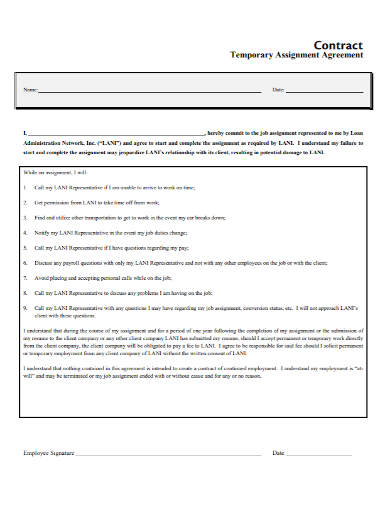
Size: 11 KB
2. Temporary Work Assignment Contract
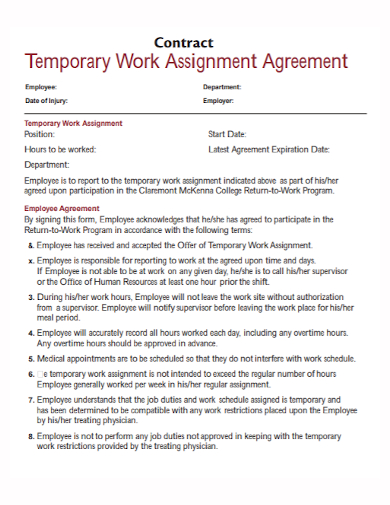
Size: 205 KB
3. Temporary Assignment Policy Contract
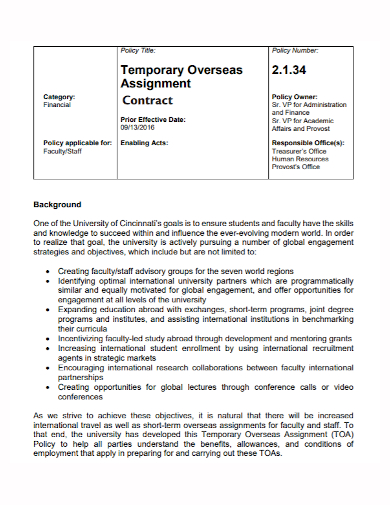
Size: 105 KB
4. Temporary Business Assignment Contract
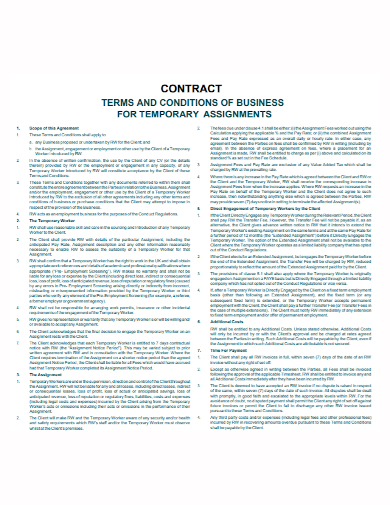
Size: 109 KB

5. Temporary Assignment Relocation Contract
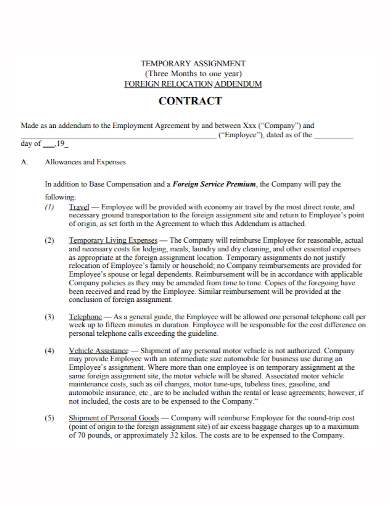
Size: 74 KB
6. Temporary Assignment Storage Contract

Size: 169 KB
7. Temporary Employment Assignment Contract
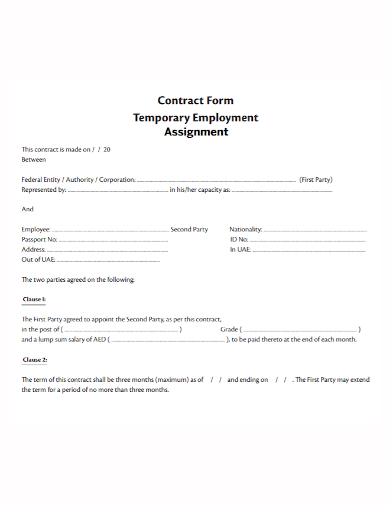
Size: 350 KB
8. Temporary Assignment Program Contract
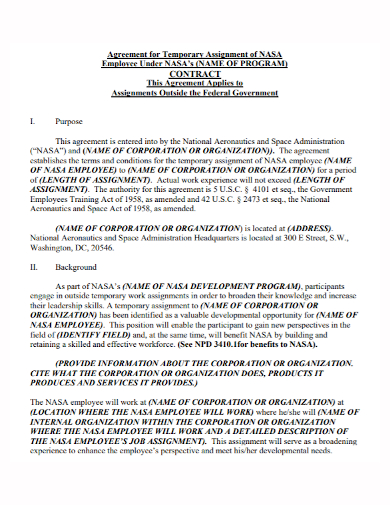
Size: 29 KB
9. Temporary Assignment Transportation Contract
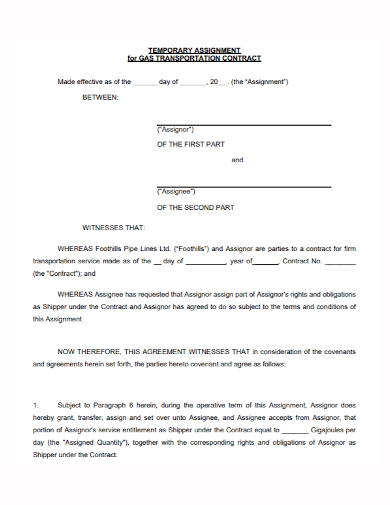
Size: 20 KB
10. Temporary Assignment Labor Contract
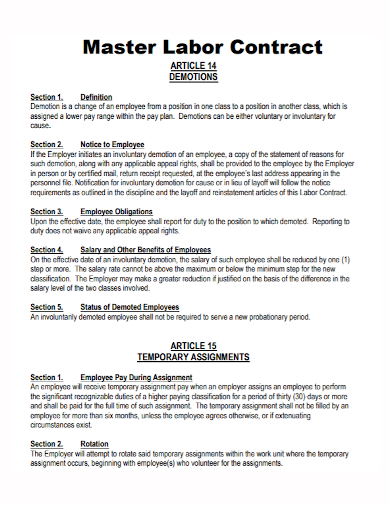
Size: 844 KB
11. Temporary Worker Assignment Contract

Size: 35 KB
What is a Temporary Assignment Contract?
A temporary assignment contract also called a temporary employment contract is a written legal agreement signed between an employer and an employee in which both parties have decided that the employee is employed in the company or organization only for a specific period. This contract will regulate the working relationship between the employer and employee.
Details to Include in a Temporary Assignment Contract
- Information of the Parties Involved: The first part of the contract must include the names and addresses of both parties involved in the contract. You must also identify who is the employer and who is the employee in the contract as well.
- Employment Terms: This section must state the main subject of the contract which is that the employee is under a temporary assignment contract and they are legally bound to follow the regulations of the contract.
- Salary and Compensation : Don’t forget to state the amount of money that will be paid for the temporary employee, how the payment will be given to them, and how often they will receive it. If the employee is eligible to receive compensation, don’t forget to present all useful information regarding this such as their leave entitlement, health care, insurance , etc.
- Employment Period: State the employment start and end date of the temporary employee. If you present an option to extend the employment contract, state the requirements needed for it.
- Rights and Responsibilities of the Parties: Describe all the rights and responsibilities that both parties are entitled to have and to observe within the agreement.
- Additional Terms: Include other important terms necessary to include in an employment contract such as severability, jurisdiction, governing law, termination of the contract , etc. to help protect both parties from legal hitches.
- Contact Information: Provide all the necessary contact information such as phone numbers and email addresses of both parties to ensure that each party can be reached anytime in case of any important instances.
- Signature Lines: Conclude the contract by providing lines where both parties can sign the contract and include the date that signifies the legality of the contract has taken place.
How long can an employee be on a temporary contract?
The maximum period for an employee to have a temporary contract usually varies from company or organization, but it is a general rule that a temporary contract must not extend beyond six months from their first day of work.
What are the benefits of having a temporary assignment contract?
For employers, having temporary assignment contracts is useful for them, especially if they need to hire employees on a whim. Some benefits include:
- When the employer hire a temporary replacement for an employee on leave
- For peak seasons, employers hire temporary workers to help with the workload increase that regular employees can no longer effectively manage
- If the company have different temporary projects to do and their employees won’t suffice to work on those projects, they hire temporary additional staff to help cover the projects
What rights does an employee have on a temporary contract?
The following rights a temporary employee has that they should exercise and the employer should respect:
- Entitled to a day off after a week’s work
- Only work to a maximum of 48 hours a week
- Entitled to leaves such as sick leave, maternity, or paternity leave
Once you’re done drafting the contract proposal, review it for any grammatical or spelling mistakes, the language and tone of the proposal, and the conciseness of its content. Revise it if needed. Encourage the employee to discuss the contract with you (make sure you’re open to answering their questions truthfully and openly) before you sign the contract. To help you get started making the contract, download our free sample templates above to use as your guide!
Related Posts
Free 10+ wholesale assignment contract samples in pdf, free 18+ financial proposal samples in pdf | ms word | google docs | pages, free 13+ witness letter samples in pdf | ms word, free 11+ awarding contract letter templates in pdf | ms word | google docs | pages, free 8+ sample material lists in ms word | pdf, free 10+ feasibility study samples in pdf, free 25+ sample contracts in pdf | ms word | excel, free 20+ readiness checklist samples in pdf, free 15+ nanny checklist samples in google docs | ms word | apple pages | pdf, free 8+ construction employment contract samples in ms word | google docs | pdf, free 7+ construction daily log samples in ms word | google docs | pdf, free 37+ supply request samples in pdf | ms word, free 13+ patient report samples in ms word | google docs | pdf, free 35+ sales request form samples in pdf | ms word, free 10+ agreement contract samples in pdf, free 19+ sample contract employee agreement, free 11+ sample novation agreement, free 9+ sample short term rental agreements, free 8+ sample casual employment agreement.
- Skip to primary navigation
- Skip to main content
- Skip to primary sidebar
- Skip to footer
Legal Templates
Home Business Assignment Agreement
Assignment Agreement Template
Use our assignment agreement to transfer contractual obligations.

Updated February 1, 2024 Reviewed by Brooke Davis
An assignment agreement is a legal document that transfers rights, responsibilities, and benefits from one party (the “assignor”) to another (the “assignee”). You can use it to reassign debt, real estate, intellectual property, leases, insurance policies, and government contracts.
What Is an Assignment Agreement?
What to include in an assignment agreement, how to assign a contract, how to write an assignment agreement, assignment agreement sample.

Partnership Interest
An assignment agreement effectively transfers the rights and obligations of a person or entity under an initial contract to another. The original party is the assignor, and the assignee takes on the contract’s duties and benefits.
It’s often a requirement to let the other party in the original deal know the contract is being transferred. It’s essential to create this form thoughtfully, as a poorly written assignment agreement may leave the assignor obligated to certain aspects of the deal.
The most common use of an assignment agreement occurs when the assignor no longer can or wants to continue with a contract. Instead of leaving the initial party or breaking the agreement, the assignor can transfer the contract to another individual or entity.
For example, imagine a small residential trash collection service plans to close its operations. Before it closes, the business brokers a deal to send its accounts to a curbside pickup company providing similar services. After notifying account holders, the latter company continues the service while receiving payment.
Create a thorough assignment agreement by including the following information:
- Effective Date: The document must indicate when the transfer of rights and obligations occurs.
- Parties: Include the full name and address of the assignor, assignee, and obligor (if required).
- Assignment: Provide details that identify the original contract being assigned.
- Third-Party Approval: If the initial contract requires the approval of the obligor, note the date the approval was received.
- Signatures: Both parties must sign and date the printed assignment contract template once completed. If a notary is required, wait until you are in the presence of the official and present identification before signing. Failure to do so may result in having to redo the assignment contract.
Review the Contract Terms
Carefully review the terms of the existing contract. Some contracts may have specific provisions regarding assignment. Check for any restrictions or requirements related to assigning the contract.
Check for Anti-Assignment Clauses
Some contracts include anti-assignment clauses that prohibit or restrict the ability to assign the contract without the consent of the other party. If there’s such a clause, you may need the consent of the original parties to proceed.
Determine Assignability
Ensure that the contract is assignable. Some contracts, especially those involving personal services or unique skills, may not be assignable without the other party’s agreement.
Get Consent from the Other Party (if Required)
If the contract includes an anti-assignment clause or requires consent for assignment, seek written consent from the other party. This can often be done through a formal amendment to the contract.
Prepare an Assignment Agreement
Draft an assignment agreement that clearly outlines the transfer of rights and obligations from the assignor (the party assigning the contract) to the assignee (the party receiving the assignment). Include details such as the names of the parties, the effective date of the assignment, and the specific rights and obligations being transferred.
Include Original Contract Information
Attach a copy of the original contract or reference its key terms in the assignment agreement. This helps in clearly identifying the contract being assigned.
Execution of the Assignment Agreement
Both the assignor and assignee should sign the assignment agreement. Signatures should be notarized if required by the contract or local laws.
Notice to the Other Party
Provide notice of the assignment to the non-assigning party. This can be done formally through a letter or as specified in the contract.
File the Assignment
File the assignment agreement with the appropriate parties or entities as required. This may include filing with the original contracting party or relevant government authorities.
Communicate with Third Parties
Inform any relevant third parties, such as suppliers, customers, or service providers, about the assignment to ensure a smooth transition.
Keep Copies for Records
Keep copies of the assignment agreement, original contract, and any related communications for your records.
Here’s a list of steps on how to write an assignment agreement:
Step 1 – List the Assignor’s and Assignee’s Details
List all of the pertinent information regarding the parties involved in the transfer. This information includes their full names, addresses, phone numbers, and other relevant contact information.
This step clarifies who’s transferring the initial contract and who will take on its responsibilities.
Step 2 – Provide Original Contract Information
Describing and identifying the contract that is effectively being reassigned is essential. This step avoids any confusion after the transfer has been completed.
Step 3 – State the Consideration
Provide accurate information regarding the amount the assignee pays to assume the contract. This figure should include taxes and any relevant peripheral expenses. If the assignee will pay the consideration over a period, indicate the method and installments.
Step 4 – Provide Any Terms and Conditions
The terms and conditions of any agreement are crucial to a smooth transaction. You must cover issues such as dispute resolution, governing law, obligor approval, and any relevant clauses.
Step 5 – Obtain Signatures
Both parties must sign the agreement to ensure it is legally binding and that they have read and understood the contract. If a notary is required, wait to sign off in their presence.

Related Documents
- Purchase Agreement : Outlines the terms and conditions of an item sale.
- Business Contract : An agreement in which each party agrees to an exchange, typically involving money, goods, or services.
- Lease/Rental Agreement : A lease agreement is a written document that officially recognizes a legally binding relationship between two parties -- a landlord and a tenant.
- Legal Resources
- Partner With Us
- Terms of Use
- Privacy Policy
- Do Not Sell My Personal Information

The document above is a sample. Please note that the language you see here may change depending on your answers to the document questionnaire.
Thank you for downloading!
How would you rate your free template?
Click on a star to rate
The Federal Register
The daily journal of the united states government, request access.
Due to aggressive automated scraping of FederalRegister.gov and eCFR.gov, programmatic access to these sites is limited to access to our extensive developer APIs.
If you are human user receiving this message, we can add your IP address to a set of IPs that can access FederalRegister.gov & eCFR.gov; complete the CAPTCHA (bot test) below and click "Request Access". This process will be necessary for each IP address you wish to access the site from, requests are valid for approximately one quarter (three months) after which the process may need to be repeated.
An official website of the United States government.
If you want to request a wider IP range, first request access for your current IP, and then use the "Site Feedback" button found in the lower left-hand side to make the request.

Temporary Employment Agreement

According to an American Staffing Association report, staffing agencies hire 16 million temporary employees every year. That’s a huge number. And it shows that a lot of employers rely on temporary workers to fulfill their workforce needs. Temporary employment is very common across different industries. That’s because it’s not throughout the year that companies need a full force of workers. There are months that they only need a few employees. If you’re one of those employers who need temporary workers, you’ve come to the right place. Before you hire temporary workers, you must write a written agreement for their employment. That’s important to seal the deal officially. So have a good look at each of our Temporary Employment Agreement Examples !
10+ Temporary Employment Agreement Examples
1. temporary employment agreement.
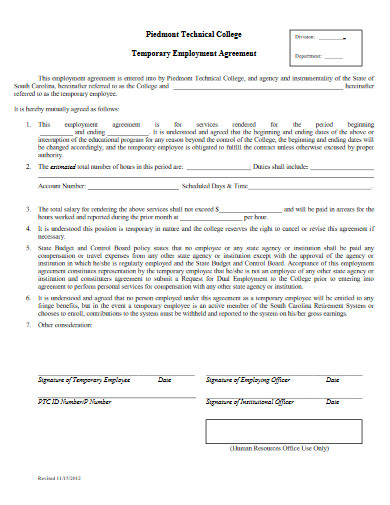
Size: 30 KB
2. Temporary Employee Services Agreement
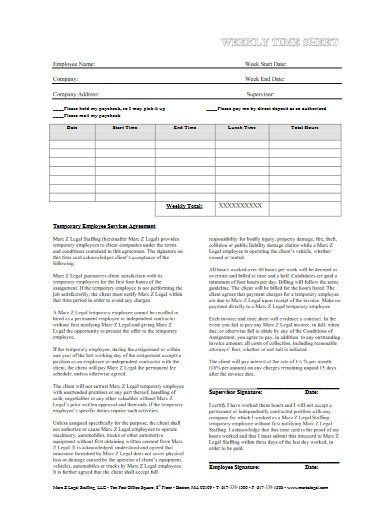
Size: 52 KB
3. Agreement for Temporary Employment
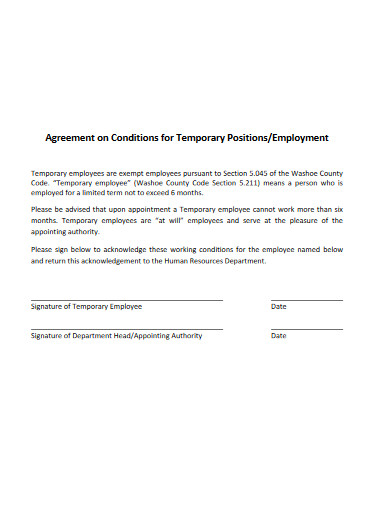
Size: 410 KB
4. College Temporary Employment Agreement

Size: 63 KB
5. Letter of Agreement- Temporary Employees
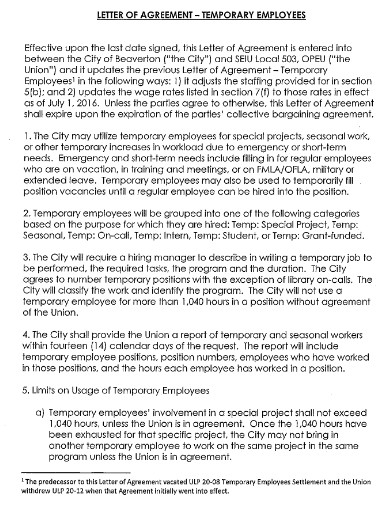
Size: 147 KB
6. Sample Temporary Employee Agreement

Size: 131 KB
7. Employment Agreement of Part Time Employee
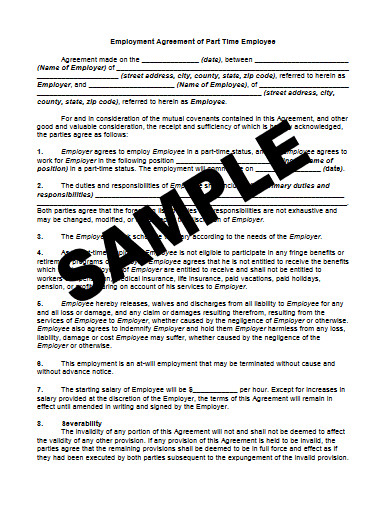
Size: 115 KB
8. Temporary Employment Contract Agreement
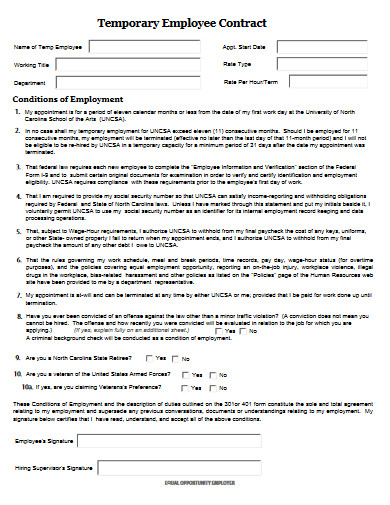
Size: 524 KB
9. Agreement for Temporary Employment Example
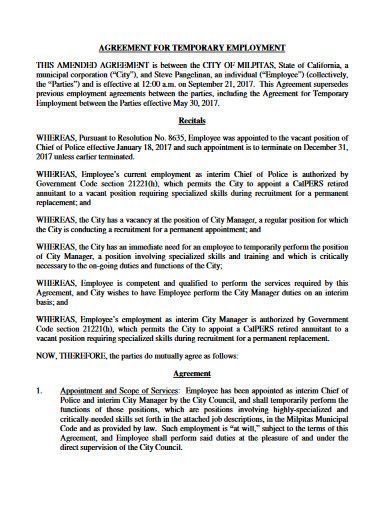
Size: 110 KB
10. College Temporary Employment Agreement in PDF
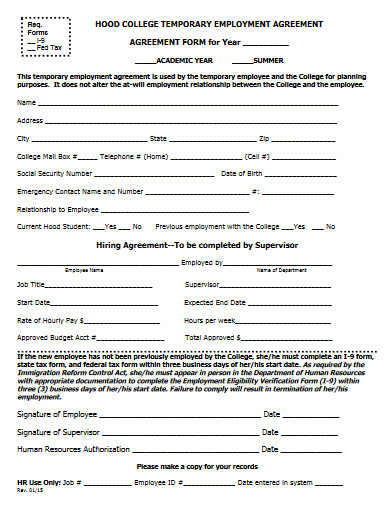
11. Basic Temporary Employment Agreement
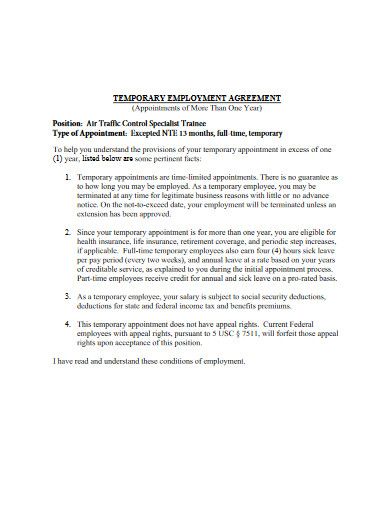
Size: 42 KB
What Is a Temporary Employment Agreement?
A temporary employment agreement is a legal document that outlines the terms and conditions of an employee’s temporary employment. It’s a specific type of job contract that emphasizes the fixed term of an employee’s stint in a company. Typically, the employment’s duration could either be for a few months or a year.
This is the document you need to prepare before hiring a temporary employee. Without it, he or she won’t be an official subordinate member of your company’s organizational chart .
Examples of Temporary Jobs
There are many temporary jobs available in the job market. Most of them are good for students who want to earn while they’re studying or do something productive during summer breaks. Temporary jobs can help the economy in some ways. And it also helps small businesses with their labor needs. Here are some examples of the best temporary jobs:
- Babysitting or nanny jobs
- Tutoring elementary or high school students
- Driving Uber or Lyft
- Delivering foods, such as pizza and other fast food orders
- Restaurant receptionist
- Restaurant waiter or waitresses
- Dog walker or sitter
- Handyperson
- Mail delivery
How to Create a Temporary Employment Agreement
As an employer, it’s your task to formulate a temporary employee agreement form . You’re the one who’ll lay out the components of the employment, not the newly-hired temporary employee. So make sure to execute these steps in creating a temporary employment agreement.
Step 1: Emphasize the Job Title
The job title should be front and center in the agreement document draft. It’s important to formally clear what the temporary employee’s job will be, even though he or she already knows it. Agreements or contracts must have complete information about what they’re about. It’s a golden rule. Emphasize the job title on the agreement document’s opening statements.
Step 2: Enumerate the Duties and Responsibilities
The employee should know what he or she will be doing on the job. And that’s why you must enumerate the duties and responsibilities of the agreement. Give the employee some snippets on what to expect once he or she starts working for you.
It’s important to enumerate the duties and responsibilities. That gives you the power, as the employer, to call out the employee if he or she neglects even one of them. It prompts the employee to complete every task required of him or her.
Step 3: State the Salary and Benefits Offer
For the employee, information about salary and benefits could be the agreement’s most crucial section. And you should understand that, as the employer. The employee has every right to be concerned about what he or she gets under your employment. So on the agreement, state the amount of salary and benefits that you’ll be offering. Be specific about how much the employee will earn daily. And on how he or she can earn incentives on the job.
There have been instances of employees backing out of employment. That’s because the temporary employment offer letter they received stated a relatively low salary and benefits. So to avoid that, make your offers fair to make the employee sign the agreement.
Step 4: Explain the Grounds for Immediate Termination
The agreement’s termination occurs when the stated last day of employment passes. That’s the time when the employee will leave your employment or sign an extension. But there’s also what’s called immediate termination. That usually happens when the employee violates strict policies . So on the agreement, you have to explain the grounds for immediate termination. The employee should know what actions he or she avoid that could prompt you to fire him or her.
Is there sick pay in a temporary employment agreement?
Whether there is sick pay or not, it depends on the employer or the company. But some state laws require employers to grant sick pays to every employee, including temporary ones.
Can I make a temporary employee permanent?
Yes, a temporary employee can become a permanent employee if he or she performs well and has good records. Once his or her temporary employment contract expires, you can offer him or her a permanent employment contract.
How should I lay off a temporary employee?
If a temporary employee’s contract is about to expire, inform him or her a month or two weeks prior. You can inform the employee through a termination letter or email. What’s important is to keep the information private.
Temporary employees come and go. They mostly don’t stay for the longer term. However, that doesn’t mean they’re less important than permanent employees. Their contributions are also integral to the company. And that’s why you must prepare employment agreement documents for them. It’s one way of showing that you value them. So download our Temporary Employment Agreement Examples now and start preparing! You can also use our Employment Contract Template .
Agreement Maker
Text prompt
- Instructive
- Professional
Formulate an agreement for student behavior in the school library
Create an agreement for participating in a school sports team.

An official website of the United States government
Here's how you know
Official websites use .gov A .gov website belongs to an official government organization in the United States.
Secure .gov websites use HTTPS A lock ( Lock A locked padlock ) or https:// means you’ve safely connected to the .gov website. Share sensitive information only on official, secure websites.
- A–Z Index
- Operating Status

Resources For
- New / Prospective Employees
- Federal Employees
- HR Professionals
Intergovernment Personnel Act
The Intergovernmental Personnel Act Mobility Program provides for the temporary assignment of personnel between the Federal Government and state and local governments, colleges and universities, Indian tribal governments, federally funded research and development centers, and other eligible organizations.
Recruitment and Hiring Policy "Myth Busters."
The Office of Personnel Management (OPM) encourages agencies to re-think the following myths and mis-perceptions:
Myth: IPAs are a popular and a widely used flexibility.
Truth: Agencies do not take full advantage of the IPA program which, if used strategically, can help agencies meet their needs for "hard-to-fill" positions such as Information Technology and Nurses.
Myth: IPAs are cumbersome to use and require OPM approval.
Truth: Agencies do not need OPM approval to make assignments under the IPA authority. Federal agencies interested in using the authority simply enter into a written agreement.
Myth: IPAs are expensive to use.
Truth: Agencies may enter into IPA assignments on a reimbursable or non-reimbursable basis. This means they may be cost-neutral to Federal agencies. Whether an IPA assignment is reimbursable is determined by the agency and non-Federal entity involved in the assignment.
Myth: An agency may only enter into an IPA agreement with a State Government entity.
Truth: An agency may enter into an IPA agreement with State and local governments, institutions of higher education, and Indian tribal governments.
Myth: Agencies receive no recruitment benefit from sending employees on IPA assignments.
Truth: Federal employees serving in IPA assignments can serve as both recruiters and ambassadors for positions in your agency. For example, Federal nurses sent to colleges and universities as teachers/instructors can inspire students about Federal employment and encourage them to consider employment with your agency via the Pathways Program. This results in a win-win for the academic institution as well as your agency.
Myth: An agency may document IPA assignments for full-time employment only.
Truth: An agency may document IPA assignments for intermittent, part-time, and full-time employment.
Contact Information
IPA Mobility Program U.S. Office of Personnel Management Room 7463 1900 E St., N.W. Washington, DC 20415
Email: [email protected]
Related Information
Report to Congress on Nursing Faculty and the Intergovernmental Personnel Act Mobility Program: The Forum, Findings, and Recommendations
Revised Intergovernmental Personnel Act
Revised Intergovernmental Personnel Act (IPA) mobility program regulations (5 CFR part 334), effective May 29, 1997, allow federal agencies to operate in a more efficient and productive manner. These new regulations contain two major changes.
Agencies are now responsible for certifying the eligibility of "other organizations" for participation in the mobility program. Previously, this certification was done by the Office of Personnel Management.
Agencies need no longer submit assignment agreements to the Office of Personnel Management. The information in this publication will assist agencies in their day-to-day management of the mobility program. questions or comments about these procedures.
- Purpose of Program
Assignments to or from state and local governments, institutions of higher education, Indian tribal governments and other eligible organizations are intended to facilitate cooperation between the Federal Government and the non-Federal entity through the temporary assignment of skilled personnel. These assignments allow civilian employees of Federal agencies to serve with eligible non-Federal organizations for a limited period without loss of employee rights and benefits. Employees of State and local governments, Indian tribal governments, institutions of higher education and other eligible organizations may serve in Federal agencies for similar periods. The legal authority for assignments under the Intergovernmental Personnel Act is 5 USC sections 3371 through 3375. The regulations can be found in Code of Federal Regulations (CFR), part 5, chapter 334.
Each assignment should be made for purposes which the Federal agency head, or his or her designee, determines are of mutual concern and benefit to the Federal agency and to the non-Federal organization. Each proposed assignment should be carefully examined to ensure that it is for sound public purposes and furthers the goals and objectives of the participating organizations. Assignments arranged to meet the personal interests of employees, to circumvent personnel ceilings, or to avoid unpleasant personnel decisions are contrary to the spirit and intent of the mobility assignment program.
The goal of the Intergovernmental Personnel Act mobility program is to facilitate the movement of employees, for short periods of time, when this movement serves a sound public purpose. Mobility assignments may be used to achieve objectives such as:
- strengthening the management capabilities of Federal agencies, State, local and Indian tribal governments, and other eligible organizations;
- assisting the transfer and use of new technologies and approaches to solving governmental problems;
- facilitating an effective means of involving state and local officials in developing and implementing Federal policies and programs; and,
- providing program and developmental experience which will enhance the assignee's performance in his or her regular job.
- Federal, State or local government employees serving under time-limited, temporary or term appointment, non-career or limited SES appointments, or Schedule C appointments;
- Elected Federal, State or local government officials;
- Members of the uniformed military services and the Commissioned Corps of the Public Health Service and the National Oceanic and Atmospheric Administration; and
- Students employed in research, graduate, or teaching assistant and similar temporary positions.
Back to Top
Certification of "Other Organizations"
The Intergovernmental Personnel Act regulations specify that "other organizations" are eligible to participate and define what an "other organization" is. They also require that entities interested in participating in the mobility program as an "other organization" have eligibility certified by the Federal agency with which they are entering into an agreement. If an organization has already been certified by an agency, this certification is permanent and may apply throughout the Federal Government. Another agency can accept this certification or require an organization to submit the appropriate paperwork for review. Requests for certification should include a copy of:
- the organization's articles of incorporation;
- Internal Revenue Service (IRS) letter of nonprofit status; and
- any other information describing the organization's activities as they relate to the public management concerns of governments or universities.
List of organizations with IPA agreements with Federal agencies includes information submitted by agencies in the FY 2010 data call.
The U.S. Office of Personnel Management does not certify organizations for participation in an IPA agreement. Each Federal Government agency certifies an organization for an IPA agreement.
- Length of Assignment
Assignment agreements can be made for up to two years, and may be intermittent, part-time, or full-time. The agency head, or his or her designee, may extend an assignment for an additional two years when the extension will be to the benefit of both organizations.
5 CFR part 334 states that an employee who has served for four continuous years on a single assignment may not be sent on another assignment without at least a 12-month return to duty with his or her regular employer. Successive assignments without a break of at least 60 calendar days will be regarded as continuous service under the mobility authority.
The regulations prohibit a Federal agency from sending on assignment an employee who has served on mobility assignments for more than a total of six years. The Office of Personnel Management may waive this provision upon the written request of the agency head.
In the case of assignments made to Indian tribes or tribal organizations, the agency head (or designee), may extend the period of assignment to any length of time where it is determined that the assignment will continue to benefit both the Federal agency and the Indian tribe or tribal organization.
- Reimbursement for Assignment
Cost-sharing arrangements for mobility assignments are negotiated between the participating organizations. The Federal agency may agree to pay all, some, or none of the costs associated with an assignment. Costs may include basic pay, supplemental pay, fringe benefits, and travel and relocation expenses.
Agencies may consider the income from certain private consulting work as part of the academic pay of university employees. Specifically, when the regular tour of duty for a university employee includes an allotment of time for consulting, or when the employee is performing any job-related consulting that cannot be continued during the assignment, the income received from the consulting may be regarded as part of the employee's academic pay.
Cost-sharing arrangements should be based on the extent to which the participating organizations benefit from the assignment. The larger share of the costs should be absorbed by the organization which benefits most from the assignment. Exceptions might occur when an organization's resources do not permit costs to be shared on a relative benefit basis.
Back to top
- Travel, Relocation, and Per Diem
A Federal agency may pay the travel expenses authorized under the Federal Travel Regulation (FTR) (41 CFR chapters 301-304) chapter 301 of a Federal employee or non-Federal employee on an Intergovernmental Personnel Act assignment. An agency may pay a per diem allowance at the assignment location in accordance with FTR part 301-7, or the following limited relocation expenses:
- travel and transportation expenses of the employee to and from the assignment location under FTR part 302-2;
- travel and transportation expenses of the employee's immediate family to and from the assignment location under FTR part 302-2;
- transportation and temporary storage expenses of the employee's household goods and personal effects under FTR part 302-8;
- temporary quarters subsistence expenses under FTR part 302-5 at the time the assignment commences and at the time the assignment is completed;
- a miscellaneous expense allowance under FTR part 302-3; and
- the expenses of non-temporary storage of the employee's household goods and personal effects under FTR part 302-9, when the employee is assigned to an isolated location.
An agency may select between payment of a per diem allowance at the assignment location or the limited relocation expenses, but may not pay both. However, an agency may pay per diem for travel away from the assignment location, even if it pays the limited relocation allowances, so long as the employee does not travel to his/her official station. An agency should consider the cost to the Federal Government to be a major factor when determining whether to pay a per diem allowance at the assignment location or limited relocation allowances. An agency should also consider the duration of the assignment. A per diem allowance is meant for shorter assignments. The payment of per diem for an indeterminate period or a period of more than one year is taxable to an employee, so an agency should not pay a per diem allowance for an assignment expected to last more than one year, or for an indefinite period.
If an agency pays a per diem allowance at the assignment location, the per diem allowance may be paid only for the individual on the mobility assignment. If an agency pays relocation, the agency may pay transportation expenses for the immediate family of the employee. An agency, however, cannot pay the expenses of selling or purchasing a residence, nor the expenses of property management services while the employee is on the assignment. An agency may not authorize a temporary change of station under subparts C and D of FTR part 302-1 to transfer an employee to the assignment location.
The employee must sign a service agreement for one year or the length of the assignment, whichever is shorter, to be eligible for payment of per diem at the assignment location or limited relocation expenses. The employee will be responsible for repaying any expenses if he or she fails to complete the service agreement, unless the reasons for failing to complete the agreement are beyond his or her control. In addition, Federal agency officials may waive the requirement to pay back expenses if they feel the waiver is justified. The service agreement does not cover travel expenses paid when the employee travels away from the assignment location.
- Standards of Conduct and Conflict-of-interest Provisions
A non-Federal employee on assignment to a Federal agency, whether by appointment or on detail, is subject to a number of provisions of law governing the ethical and other conduct of Federal employees. Title 18, United States Code, prohibits certain kinds of activity:
- receiving compensation from outside sources for matters affecting the Government (section 203),
- acting as agent or attorney for anyone in matters affecting the Government (section 205),
- acting or participating in any matter in which he or she, the immediate family, partner; or, the organization with which he or she is connected has a financial interest (section 208),
- receiving salaries or contributions from other than Government sources for his or her Government services (section 209),
- soliciting political contributions (sections 602 and 603),
- intimidating to secure political contributions (section 606),
- failing to account for public money (section 643),
- converting property of another (section 654),
- disclosing confidential information (section 1905); and,
- lobbying with appropriated funds (section 1913).
Non-Federal employees are also subject to the Ethics in Government Act of 1978; 5 CFR part 735 which regulates employee responsibilities and conduct; as well as agency standards of conduct regulations. The Intergovernmental Personnel Act does not exempt a Federal employee, whether on detail or on leave without pay, from Federal conflict-of-interest statutes when assigned to a non-Federal organization. The Federal employee may not act as an agent or attorney on behalf of the non-Federal entity before a Federal agency or a court in connection with any proceeding, application, or other matter in which the Federal Government is a party or has a direct and substantial interest. The Federal agency should be particularly alert to any possible conflict-of-interest, or the appearance thereof, which may be inherent in the assignment of one of its employees. Conflict-of-interest rules should be reviewed with the employee to assure that potential conflict-of-interest situations do not inadvertently arise during an assignment.
Under the terms of the Indian Self-Determination and Educational Assistance Act , Federal employees on assignment to an Indian tribal government are exempt from conflict-of-interest provisions concerning representational activities, provided the employee meets notification requirements. Federal employees may act as agents or attorneys for, or appear on behalf of, such tribes in connection with any matter pending before any department, agency, court, or commission, including any matter in which the United States is a party or has a direct and substantial interest. The Federal assignee must advise, in writing, the head of the department, agency, court, or commission with which he or she is dealing or appearing on behalf of the tribal government, of any personal and substantial involvement he or she may have had as an officer or employee of the United States in connection with the matter involved.
Non-Federal employees on assignment to the Federal Government are subject to the provisions of 5 USC chapter 73, United States Code (Suitability, Security, and Conduct, including restrictions on political activity), and any applicable non-Federal prohibitions.
- Arranging an Assignment
Assignments under the Intergovernmental Personnel Act are management-initiated. Development of the proposed assignment should be controlled by management. The benefits to the Federal agency and the non-Federal organization are the primary considerations in initiating assignments; not the desires or personal needs of an individual employee. The assignment is voluntary and must be agreed to by the employee. Regulations require that an assignment must be implemented by a written agreement.
When developing an assignment which involves the movement of a non-Federal employee to a Federal agency, the agreement should specify that the employee can return to the non-Federal position occupied prior to the assignment or to one of comparable pay, duties and seniority and that the employee's rights and benefits will be fully protected.
Federal agencies should use their own form for recording the agreement. The specific content of the agreement may vary according to the assignment. Agency forms should provide, at a minimum, the following information:
- name, social security number, current job title, salary, classification, and address of the employee,
- parties to the agreement (both Federal and non-Federal organizations),
- position information, including organizational location of both the original position and the position entered into under the agreement,
- type of assignment (e.g., detail or leave without pay; non-Federal to Federal; Federal to non-Federal), and period covered by the assignment agreement,
- goals of the assignment and a brief statement of how the goals are to be achieved,
- relative benefits accruing to each organization and the cost-sharing arrangement based on these benefits,
- how increased knowledge, skills and abilities gained by the employee during the assignment will be utilized at the completion of the assignment,
- applicability of Federal conflict-of interest laws,
- decisions of the Federal agency and the non-Federal organization concerning the employee's salary, supervision, payment of travel and transportation expenses, supplemental pay, entitlement to leave and holidays, provisions for reimbursement and the method of reimbursement,
- arrangements for maintaining leave records,
- employee benefits that will be retained; and,
- Privacy Act Statement.
The agreement should also make clear that if an employee is paid allowable travel, relocation, and per diem expenses, he or she must complete the entire period of the assignment or one year, whichever is shorter, or reimburse the Government for those expenses.
For Federal employees the agreement should assure that the assignee knows of his or her obligation to return to the Federal service for a time equal to the length of the assignment, or be liable for all expenses (exclusive of salary and benefits) associated with the assignment.
The cost-sharing arrangements involved in a mobility assignment are worked out between the participating organizations. The Federal agency may agree to pay all, some, or none of the costs of an assignment. Such costs may include employee pay, fringe benefits, relocation costs, and travel and per diem expenses.
- Termination of an Assignment
An assignment may be terminated at any time at the option of the Federal or non-Federal organization. Where possible, the party terminating the agreement before the original completion date should give a 30-day notice to all parties involved. This notification should be in writing and should include the reasons for the termination. The Office of Personnel Management may terminate an assignment or take other corrective actions when an assignment is found to violate the Intergovernmental Personnel Act regulations. A mobility assignment must be terminated immediately whenever the assignee is no longer employed by his or her original employer, regardless of whether the assignment is a detail or an appointment.
- Changes to the Assignment Agreement
Any significant changes in an employee's duties, responsibilities, salary, work assignment location or supervisory relationships should be duly recorded as a modification to the original agreement. The assignment agreement for each employee must always be accurate, complete, and current. Minor changes such as salary increases due to annual pay adjustments, changes in benefits due to revised coverage, and very short-term changes in duties do not require a modification to the original agreement.
The Office of Personnel Management will maintain oversight over agencies' use of the Intergovernmental Personnel Act program. It is imperative that agencies maintain accurate records of all Intergovernmental Personnel Act assignments (see Arranging an Assignment) as well as eligibility certifications of "other organizations." In addition, the Office of Personnel Management's Office of Merit Systems Oversight and Effectiveness may conduct, as appropriate, reviews of agencies' administration of the Intergovernmental Personnel Act program.
On this page
- Revised IPA
- Other Organizations
- Status of Employee
An employee of a non-Federal organization must be employed by that organization for at least 90 days in a career position before entering into an Intergovernmental Personnel Act agreement. This individual may be given a temporary appointment or be assigned by detail to a Federal agency. It is the Federal agency's responsibility to inform the employee of the applicable Federal employee laws. Federal conflict-of-interest laws and the Federal tort claims statutes also apply.
A non-Federal employee who is assigned to a Federal position, either by detail or appointment, may serve as a project lead and perform project management leadership activities such as assigning work, establishing project milestones, completion dates, etc. A non-Federal employee who is assigned to a Federal position, either by detail or appointment, cannot perform other aspects of the Federal supervisory function, such as conducting an employee’s annual performance rating, engaging in performance based or adverse action procedures, rewarding employees, etc.
Agencies should not offer permanent appointments to non-Federal employees assigned to them. The Intergovernmental Personnel Act mobility program is not to be used as a mechanism to facilitate career changes.
Non-Federal employees on assignment to a Federal agency by appointment are Federal employees for the duration of that appointment and have all the rights, benefits, and privileges associated with that appointment. This includes eligibility for awards given under the authority of 5 USC chapter 45.
Non-Federal employees on assignment to a Federal agency by detail can receive recognition through letters of appreciation or commendation but are not eligible for awards granted under the incentive awards programs governed by 5 USC chapter 45. A Quality Step Increase (QSI) cannot be approved for non-Federal employees.
- Status of a Non-federal Employee on Detail
Non-Federal employees on detail to Federal agencies remain employees of their permanent organizations for most purposes. Detailees are not eligible to enroll in Federal health benefits programs, group life insurance, or the Civil Service Retirement System (CSRS). An employee assigned by detail to a Federal agency may be assigned to an established, classified position in the Federal agency, or may be given a set of ad hoc, unclassified duties, relevant only to the specific assignment project.
An employee assigned by detail to a classified position in a Federal agency is entitled to earn the basic rate of pay, including any locality payment, which the duties of the assignment position would warrant under the applicable classification and pay provisions of the Federal agency. If the assignee's non-Federal salary is less than the minimum rate of pay for the Federal position, the agency must supplement the salary to make up the difference. Supplemental pay may vary because of changes in the rate of pay of the Federal position. It cannot be paid in advance or in a lump sum and is not conditional on the completion of the full period of the assignment. Supplemental pay may be paid directly to the employee or reimbursed to the non-Federal organization.
If the assignee is detailed to a set of unclassified duties, the assignee continues to be paid directly by the non-Federal organization at a rate of pay based on the assignee's non-Federal job. The Federal agency may agree to reimburse the non-Federal organization for all, some, or none of the costs of the assignment.
Detailees will usually have the same workweek and hours of duty as Federal employees in the agency to which they are assigned. However, if the workweek of the permanent employer is, by law or local ordinance, shorter than the Federal workweek, the employee's workweek should be adjusted as needed. Detailees are eligible to participate in alternative work schedule arrangements of the Federal agency to which they are assigned.
Detailees are covered under their permanent employer's leave system. The assignment agreement will specify how the permanent employer will be notified of leave taken and how the use of leave will be approved. The agreement will also spell out what holidays will be observed by the assignee.
- Status of a Non-federal Employee Receiving a Federal Appointment
By statute, a non-Federal employee may be given an excepted appointment for two years without regard to the provisions governing appointment in the competitive service. This appointment may be extended for not more than an additional two years. Agencies should establish qualification requirements for assignment positions in accordance with 5 CFR part 302, which governs employment in the excepted service.
The Intergovernmental Personnel Act noncompetitive appointment authority provisions of 5 USC section 3372 apply only to positions in the competitive service. In order to appoint a non-Federal Intergovernmental Personnel Act assignee to an SES position, an agency must first obtain an SES limited term appointment authority from the Office of Personnel Management. However, only SES General positions may be filled by limited appointment, i.e., a non-Federal employee cannot be given a limited term appointment to an SES Career Reserved position. Requests for allocation of an SES limited term appointment authority for non-Federal Intergovernmental Personnel Act assignees should be directed to the Deputy Associate Director, Employee Relations and Executive Development, Room 7412, 1900 E Street NW, Washington, DC 20415-0001.
Normally, a non-Federal employee is appointed at the minimum rate of the grade. However, if an agency wants to pay an advanced step rate for a position at GS-11 through GS-15 based upon superior qualifications of the applicant, it may do so.
Intergovernmental Personnel Act assignees appointed for more than one year are eligible for within-grade increases. They are entitled to cost-of-living allowances and other pay differentials, and are allowed to accumulate and use leave to the same extent as other Federal employees. However, employees appointed to successive temporary appointments of one year or less may not earn a within-grade increase, even if the time under the successive temporary appointments exceeds one year.
A non-Federal employee is not eligible to enroll in the Federal Employees Health Benefits program unless his or her Federal appointment results in the loss of coverage under the non-Federal health benefits system. In such a case, the appointee may enroll in the Federal Employees Health Benefits Program.
Non-Federal employees given appointments are not covered by any retirement system for Federal employees or by the Federal Employees Group Life Insurance Program
Questions or comments regarding this program may be submitted to: [email protected]
Javascript est desactivé dans votre navigateur.
République Française
Entreprendre .Service-Public.fr
Le site officiel d'information administrative pour les entreprises
- Accéder au site pour les particuliers
Sélectionnez une commune dans la liste des suggestions
Une erreur est survenue pendant la recherche, merci de réessayer.
This page has been automatically translated. Please refer to the page in French if needed.
Share the page
Link copied
Temporary employment contract (temporary)
Verified 16 August 2021 - Directorate for Legal and Administrative Information (Prime Minister)
Corresponds to all days of the week except the weekly day of rest (usually Sunday) and public holidays usually not worked in the company
Supplementary document of the contract stating that the two parties have agreed to amend, adapt or supplement the contract
Elapsed period between 2 events
Corresponds to all calendar days in the calendar year, from 1 er January to December 31, including public holidays or non-working days
Amount of money intended to compensate for the damage suffered
The temporary assignment shall be for a period specified in the contract of employment, but may not exceed the maximum legal duration, which may vary according to the nature of the assignment. During the assignment, the temporary employee shall enjoy the same rights as other employees. A temporary employee shall receive a precarious allowance and a paid leave allowance at the end of the assignment. The contract of assignment may be terminated, subject to conditions.
The temporary employee signs a contract of assignment with the temporary company of work.
A supply contract shall be concluded between the temporary company of work and the company where the temporary agency worker carries out his assignment.
The contract of assignment must be written and signed by the employee.
The contract is transmitted to the employee at the latest within 2 working days according to its availability.
It shall contain the following information:
- Reference to the contract of supply (concluded between the temporary company of work and the company where the temporary agency works) is repeated
- Professional qualification of the employee
- Pay Terms (Periodicity of Payment)
- Duration of the trial period
- Name and address of the supplementary pension fund and the provident society responsible for the temporary company of work
- Clause stating that at the end of the assignment, hiring by the user company is not prohibited
- Clause mentioning that repatriation is the responsibility of the temporary company of work (if the mission is outside the metropolitan area)
if not drawn up in writing and signed, the contract may be requalified on a DTA.
Contract with specific term
A temporary assignment shall have a specific term when the contract provides for a firm expiry date.
A specific term is mandatory in the following 2 situations:
- The purpose of the contract is to provide for the replacement of an employee temporarily employed on a part-time basis
- The contract is intended to provide for the replacement of an employee who has left definitively before the abolition of his post
- The contract is intended to ensure a temporary increase in the company's activity
Please note
no minimum contract duration is to be expected, except in the case of exceptional export orders (the initial contract duration may not be less than 6 months).
Contract without a specific term
The contract is not necessarily subject to a specific term when the temporary worker is acting in the following cases:
- Replacement of absent employee
- Replacement of an employee whose employment contract is suspended
- Waiting for the arrival of an employee hired on a permanent contract
- Seasonal employment (e.g. harvests)
- Employment the use of which excludes the use of a CDI (e.g. moving or hotel sectors)
- Replacement of a head of company, a head of agricultural holding or a person engaged in a liberal activity (or the absent spouse when he or she actively participates in the activity of the company or holding)
In one of these cases, the termination of the contract of assignment is foreseen at the end of the absence of the replaced person or at the achievement of the object for which the contract was concluded.
the contract without a precise term shall be concluded for a minimum period to be determined freely.
The maximum duration of the acting contract varies according to the nature of the assignment, including renewal.
Trial period
The contract of assignment may include a trial period.
The length of the trial period is fixed by collective agreement or collective agreement.
In the absence of an agreement, the maximum duration of the trial period depends on the duration of the contract.
Contract of less than 1 month
1-2 month contract, contract longer than 2 months.
The trial period is 2 days maximum.
The trial period is 3 days maximum.
The trial period is a maximum of 5 days.
Regardless of its term (precise or not), the assignment contract may be renewed twice if the total duration of the contract, taking into account the renewal, does not exceed the maximum authorized duration.
The conditions for such renewal must be laid down in a clause inserted in the contract of employment or in a agreeable offered to the employee before the original scheduled term.
Employee situation
The temporary employee enjoys the same rights as other employees of the company throughout the period of his assignment (catering, transport, etc.).
A temporary worker shall be entitled to a salary on the same terms as other employees in the company in which he is employed.
The temporary agency shall receive at least:
- the salary which may be received by another employee of the company, with equivalent qualifications and work position (after a trial period),
- any bonuses and salary accessories provided for in equivalent qualifications and positions.
Public holidays must be paid to the temporary employee, without seniority condition, if the other employees of the company benefit from this payment.
in the construction or public works sector, temporary workers must be paid the same amount as other employees and without any seniority condition.
End-of-mission allowance (precarious allowance)
At the end of each assignment, the employee must receive, in addition to his salary, an end-of-assignment allowance, more often called precarious premium .
However, payment of this premium shall not be due in the case of:
- Conclusion of a DTA with the user company immediately after the end of the mission
- Additional vocational training provided to the employee by the user company at the end of the mission
- Early termination of the contract at the employee's initiative
- Early termination of contract for gross negligence or for force majeure
- Seasonal contract (if the agreement or agreement applicable in the company does not provide for termination indemnity)
The amount of the allowance shall not be less than 10% the gross total remuneration, including renewal of the contract.
A computation simulator is available:
Calculating an employee's precarious allowance
The precarious allowance shall be paid at the end of each mission and at the same time as the last salary due.
the amount of this bonus is shown on the last salary slip.
Paid leave allowance
A temporary employee shall be entitled to a compensatory allowance for paid leave for each assignment he carries out, irrespective of the duration of the assignment.
The amount of the PTO is calculated as:
- depending on the duration of the mission,
- not be less than 10% the total gross remuneration of the temporary employee (including the end-of-service allowance).
Some absences are taken into account during the mission:
- Maternity and adoption leave
- Accident at work Stoppages due to occupational illness or illness, up to a continuous period of one year
- Recall periods in the armed forces if the point of departure of those periods occurs during a mission
The allowance is paid at the end of the mission.
Termination
End of mission, general case, employee hiring.
In the absence of recruitment at the end of the mission, the employee is entitled to payment of an end-of-mission allowance to compensate for the precariousness of his situation.
The employer must provide you with all of the following:
- Work Certificate
- Pôle emploi Attestation
- Balance of all accounts
- Participation schemes, profit-sharing schemes, wage savings plans within the company, summary statement of all sums and securities saved
At the end of his assignment, the employee made available may be hired by the user company.
In this case, the length of the assignments carried out within that company during the 3 months preceding recruitment shall be:
- taking into account for calculating the length of service of the employee
- and deducted from the trial period, if the new contract provides for one.
if the user company employs a temporary employee after the end of his assignment without a contract, the judge may reclassify the assignment contract as a contract of indefinite duration (CDI).
Waiting period
In the absence of any provision to the contrary provided for in the collective agreement or a branch agreement, where the contract of assignment ends, a waiting period applies. A deadline must be met before using a new assignment contract or a CDD on the same workstation.
The method of calculation varies according to the duration of the contract, under the following conditions:
- For contracts of at least 14 days, the time limit shall be one third of the duration of the previous contract (including renewal).
- For contracts of less than 14 days, it is fixed at half the duration of the previous contract (including renewal).
The duration of the contract shall be assessed in calendar days , but the waiting period shall be counted in the opening days of the establishment concerned.
In the absence of provisions to the contrary provided for in the collective agreement or a branch agreement, the waiting period shall not apply in the following cases:
- New absence of the replaced employee, if the assignment contract is concluded to replace an employee temporarily absent or whose employment contract is suspended
- Employment of a seasonal nature or for which it is customary not to have recourse to a CDI
- Urgent work required for safety measures
- Refusal by the employee to renew his contract (period not taken into account for the duration of the non-renewed contract)
- Contract concluded for the replacement of a farm manager, a caregiver, a farm partner or their spouse
- Contract concluded with a view to replacing a head of a craft, industrial or commercial company, a person exercising a liberal profession, his or her spouse or a self-employed member of a professional civil business, a civil business of means or a business of liberal practice
Early termination of the contract
Disruption at the initiative of the employer, disruption at the initiative of the employee.
The employer who breaks the contract of employment must propose to the employee a new contract of employment with effect within a maximum of 3 days once the termination is made.
The new contract of assignment may not involve changes to an essential element in respect of professional qualifications, remuneration, working hours and transport time.
If the new contract is of a shorter duration than the previous contract, the employer must pay the employee compensation. This allowance shall be equal to the remuneration he would have received up to the end of the contract, including the end-of-mission allowance.
the employer may terminate the contract of employment without any special obligations vis-à-vis the temporary worker during the trial period , in the case of gross negligence of the employee or in the case of force majeure . In such cases, the employer is not obliged to propose a new employment contract to the employee.
You can terminate your acting assignment early in the following cases:
- Either during the trial period without any particular reason
- In the case of hiring on a permanent contract
- Or in the case of force majeure
if you terminate your acting assignment after the probationary period and outside of authorized cases, you may be ordered by the judge to pay your employer damages .
Who can help me?
Find who can answer your questions in your region
Telephone administrative information - Allo Public Service
The informants who answer you belong to the ministry responsible for labor.
Cost: free service
Attention: the service does not respond questions relating to unemployment compensation and representations to Pôle emploi, civil servants or public service contractors, the amount or payment of social, wage or employer contributions.
The service is available at the following times:
- Monday: 8.30am to 5.30pm
- Tuesday: 8:30 to 12:15
- Wednesday: 8:30 to 12:15
- Thursday: 8.30am to 5.30pm
- Friday: 1 p.m. to 4:15 p.m
- Lundi : de 08h30 à 17h30
- Mardi : de 08h30 à 12h15
- Mercredi : de 08h30 à 12h15
- Jeudi : de 08h30 à 17h30
- Vendredi : de 13h00 à 16h15
Request a call
Statute and miscellaneous references
Labor Code: Articles L1251-42 to L1251-44
Supply Agreement
Labor Code: Articles L1251-16 to L 1251-17
Contract of assignment
Labor Code: Articles L1251-5 to L1251-8
Use of the contract of assignment (Article L1251-6)
Labor Code: Articles L1251-11 to L1251-13
Term and duration of the contract of assignment
Labor Code: Articles L1251-35 to L1251-35-1
Renewal of the mission contract
Labor Code: Article D1251-1
Period of use (sectors of activity)
Labor Code: Article L1251-38
Hiring at the end of the mission
Labor Code: Articles L1251-39 to L1251-41
Requalification as a CDI
Labor Code: Articles L1251-36 to L1251-37-1
Labor Code: Articles L1251-18 to L1250-20
Remuneration (Article L1251-18), holiday pay (Article L1251-19), weather pay (L1251-20)
Labor Code: Articles L1251-29 to L1251-34
Precarious allowance (Article L1251-32)
Labor Code: Articles L1251-26 to L1251-28
Early termination of the contract of assignment
Labor Code: Article L1251-25
Information on vacancies
Labor Code: Articles L1251-14 and L1251-15
Online services and forms
Monthly statement of temporary employment contracts
Online service
Does a European national employed in France have the same rights as a French employee?

IMAGES
VIDEO
COMMENTS
Get An Assignment Agreement Using Our Simple Step-By-Step Process. Start Today! Legal Made Simple. Create Legal Documents Using Our Clear Step-By-Step Process.
Complete and download your contract online. It's quick and easy! Complete in 5 min. Simple and easy. 100% online. Already 3,000,000 users.
A temporary employment agreement is signed to oversee the conditions of an employment relationship that is supposed to last for a short period of time. This form of contract is made between a company with its potential individual employee or two different companies. It is also known as an interim employment agreement.
Temporary Assignment. A staff member assigned by the University for twenty (20) working days or more to perform all, or the principal duties, of a position with a higher Ceiling shall receive a salary adjustment in accordance with article 21.07. Such acting pay is not payable to a staff member whose position requires the staff member to perform periodically the principal duties of the higher ...
This temporary employee contract template specifically covers hiring a new employee for a temporary position. Temp workers have a seasonal demand — for example, when it's the holiday season, there is a need for more hands on deck. When you're hiring a temp employee, you can still be responsible for tasks like withholding income tax and ...
Here is an employment contract sample that includes the sections mentioned. Terms of Agreement. This temp-to-hire agreement is between the company (name) of (address and phone number) and the worker (name) of (address and phone number). The worker will start this temporary assignment on (date) and continue until (date), after which the worker ...
Using a Temporary Employment Contract can provide a company with legal protection when hiring a short-term employee by making clear that the position is strictly temporary. This stipulation permits an employer to avoid the legal obligations that come with hiring a permanent employee. The temporary employee is also considered "at-will," allowing ...
The main benefit of a temporary assignment is that there is no notice period for both the employer and employee up to 13 weeks of employment. One week's notice will be required by both parties thereafter. Fixed-term contracts (FTC). Another great option with many benefits is a fixed-term contract (FTC).
Temp contracts are extremely important because they set out the rules for the relationship between an employer and a temporary employee. A proper contract protects the business from liability and from paying unemployment benefits when the employees' contract is complete. The three employment contract types are temporary, permanent, and ...
The DOL states that a temporary job is (by law) a job that lasts less than 12 months. Anything after that must be treated as a long-term employee with the appropriate rights and benefits. Exempt ...
Temporary employment is an employment arrangement that is intended to last for only a limited period of time, for example, a week, a month, or half a year. It may also terminate because it was undertaken to serve a certain specified, limited goal, and the goal is achieved, such as the completion of a construction project.
Temporary contract workers are self-employed individuals that companies hire for a period of time to complete a task or fill a position. Instead of signing a W-2 tax form, companies sign a contract determining their wages and work responsibilities, and the contract workers calculate their state and federal taxes themselves through 1099 forms.
Temporary employment is a work arrangement in which an employer and employee have a short-term contractual relationship. The commitment of both parties only lasts for a specified period or when an assignment is finished. Employees of this type of employment are also sometimes called. Temps.
How to Write. The following information needs to be included in a temporary employment contract. 1. Names of the Employer and Employee. This ensures it's clear who the contract is between. 2. Job Title and Description. This contract section is designed to set out the employee has responsibilities during their employment period.
Temporary assignments are subject to a written agreement detailing the terms of the assignment and the approximate duration. The distance of the new work location must be greater than 50 miles ...
Isabelle Brissette, a McKesson Canada compensation consultant, noted the company had 29 temporary assignments for the past fiscal year. "Some of our maternity/parental leaves can last up to 18 months," she said. Having a formal process in place makes good business sense, Brisette said, because when an employee takes on a new temporary role ...
What is a Temporary Assignment Contract? A temporary assignment contract also called a temporary employment contract is a written legal agreement signed between an employer and an employee in which both parties have decided that the employee is employed in the company or organization only for a specific period. This contract will regulate the working relationship between the employer and employee.
Assignment Agreement Template. Use our assignment agreement to transfer contractual obligations. An assignment agreement is a legal document that transfers rights, responsibilities, and benefits from one party (the "assignor") to another (the "assignee"). You can use it to reassign debt, real estate, intellectual property, leases ...
Conversations about the legal length of a temporary assignment has been around for a long time. In December 2000, the now infamous Microsoft 97 million $ settlement ... While higher wage temporary or contract workers tend to prefer "longer term assignments", many lower wage temporary workers consider themselves negatively impacted when ...
Temporary Assignment Agreement - The University of North Carolina at Pembroke . I agree to accept temporary employment at UNC Pembroke on the following terms: 1. Prior to reporting to work I must complete and submit a W-4 (W-4 Employee's Withholding Allowance Certificate ) and NC-4 (NC-4 Employee's Withholding Allowance Certificate )
PART 334—TEMPORARY ASSIGNMENTS UNDER THE INTERGOVERNMENTAL PERSONNEL ACT (IPA) Authority: 5 U.S.C. 3376; E.O. 11589, 3 CFR 557 (1971-1975) ... Federal agencies must maintain a copy of each assignment agreement form established under this part, including any modification to the agreement. The agency may determine the appropriate time period ...
So make sure to execute these steps in creating a temporary employment agreement. Step 1: Emphasize the Job Title. The job title should be front and center in the agreement document draft. It's important to formally clear what the temporary employee's job will be, even though he or she already knows it.
temporary quarters subsistence expenses under FTR part 302-5 at the time the assignment commences and at the time the assignment is completed; ... The assignment agreement will specify how the permanent employer will be notified of leave taken and how the use of leave will be approved. The agreement will also spell out what holidays will be ...
The temporary assignment shall be for a period specified in the contract of employment, but may not exceed the maximum legal duration, which may vary according to the nature of the assignment. During the assignment, the temporary employee shall enjoy the same rights as other employees. A temporary employee shall receive a precarious allowance ...
Assignability clauses. Assignability clauses are often encountered in real estate contracts, where they allow the transfer of property or leases. Assignment of contract can also be applied to some options and futures contracts. Not all contracts have an assignment provision. If one does, it can be found in the contract's terms.
A few highlights of the updated contract include: A new definition of workplace bullying, which will better protect employees. Temporary Compassionate Assignments up to 60 days to an alternate duty station for a temporary personal situation outside of their control for reasons such as the illness of a parent.
Contractual Arrangement: Temporary appointment under Staff Rule 420.4. Contract Duration (Years, Months, Days): 19 months. Posting Date May 6, 2024. Closing Date May 28, 2024. Primary Location India-New Delhi. Organization SE/HPN Healthier Populations & Noncommunicable Diseases. Schedule Full-time